CARLOS MIGUEL PRIETO MUSIC DIRECTOR
melody rhythmdynamics form tempo texture finale introduction
what makes music,
Made possible by
The Bastian Family Charitable Foundation
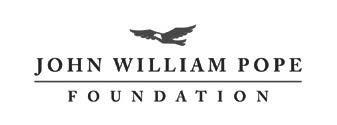
NORTH CAROLINA SYMPHONY EDUCATION SUPPORTERS
These concerts are made possible by a generous grant-in-aid from the State of North Carolina; the Honorable Roy Cooper, Governor; and D. Reid Wilson, Secretary, North Carolina Department of Natural and Cultural Resources. NCS also gratefully acknowledges the following supporters:
EDUCATION SUSTAINERS
EDUCATION
BENEFACTORS
EDUCATION PATRONS
The Bastian Family Charitable Foundation
Anonymous, Anonymous Trust / Simple Gifts Fund


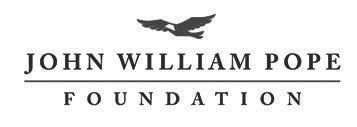
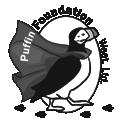

Ron & Nancy McFarlane

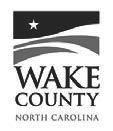
The Mildred Sheffield Wells Charitable Trust

Catharine Biggs Arrowood, Joseph C. and Diane Bastian, The Hillsdale Fund, Robert P. Holding Foundation, Inc., The Krasberg Mason Foundation, Samuel P. Mandell Foundation, James J. and Mamie R. Perkins Memorial Fund, Eddie and Jo Allison Smith Family Foundation, Inc., Chris and Kalesia Woody, Mrs. Darliene Woolner, Youths’ Friends Association Inc.
EDUCATION PARTNERS
Mark and Gayle Acuff
Anonymous Fund
APCO Worldwide
Avidex
The Backyard Foundation
Bailey Endowment, Inc.
Bailey’s Fine Jewelry
Balsam Mountain Preserve Gift Fund for Jackson County
The Harold H. Bate Foundation
Bertsch Family Charitable Foundation, Inc.
The Borden Fund, Inc.
BridgePoint General Contracting
R.A. Bryan Foundation, Inc.
Mary Grey Burney Foundation
Carolina Hurricanes
Carteret Community Foundation
celito
The Cole Foundation
Mr. and Mrs. Jeffrey A. Corbett
Craven County Community Foundation
Edna Williams Curl and Myron R. Curl Charitable Fund
Dr. Albert Joesph Diab Foundation
The Dickson Foundation, Inc.
Dover Foundation, Inc.
Drucker + Falk
William C. Ethridge Foundation, Inc.
The Lundy Fetterman Family Foundation Trust
First Citizens Bank
Fox Rothschild LLP
Franklin County Community Foundation
George Foundation, Inc.
Girl Scouts—North Carolina
Coastal Pines
Gipson Family Foundation
Gregory Poole Equipment
The Hellendall Family Foundation of North Carolina
Mr. Terry A. Henderson
HH Architecture
Hickey Family Foundation
Hitachi Astemo
Bill and Susan Hodges
Yaoqing & Shouying Huang Family Foundation
Iredell County Community Foundation
John and CeCe Kennedy
William R. Lampe
Sandi Macdonald & Henry Grzes
Dawn and Gregg MacLaren
Jane McNair Marr
Dr. Neil McLeod
Moore County Community Foundation
NACEO: National Association of Chief Executive Officers
New Bern Rotary Charitable Foundation, Inc.
North Carolina Symphony Boards of Trustees
O2 Fitness
Onslow County Government
Outer Banks Community Foundation
Poole Family Foundation
Mr. and Mrs. James Arthur Pope
W. Trent Ragland, Jr. Foundation
Raleigh Fine Arts Society, Inc.
Rete Mirable Fund
Florence Rogers Charitable Trust
E.T. Rollins, Jr., and Frances P. Rollins Foundation
Mrs. Frances P. Rollins
The Norman and Rose S. Shamberg Foundation
Mr. and Mrs. Henry L. Smith
Smith Anderson
David Sontag
Southern Bank Foundation
Sandra L. Sully
TCHROA: Triangle Chief Human Resources Officers Association
The Titmus Foundation
UNC Health
VACO
Vance County Community Foundation
Isabel Villa-Garcia
Alex and Barbara Wilson Charitable Foundation, Inc.
Margaret C. Woodson Foundation
Authors: Luke Arno, Rody J. Huertas, Caitlin Joyner, Alexis Kagel, Eileen Mueller, Tonya N. Suggs
Designer: Jennifer Blackman, Graphic Designer, North Carolina Symphony
Editors: Jason Spencer, Director of Education, North Carolina Symphony
MUSIC EDUCATION ENDOWMENT FUNDS
The Joseph C. and Diane E. Bastian Fund for Music Education
The Ruby and Raymond A. Bryan Foundation Fund
The Jeffrey and Jean Corbett Endowed Fund for Music Education
The Marilyn Ehrenshaft and John Williamson Young Musician Master Class Endowed Fund
The Mary Whiting Ewing Charitable Foundation Fund
The Hulka Fund for Chamber Music
The Janirve Foundation Fund
The Elaine Tayloe Kirkland Fund
The Gwinn Marie Moss Endowed Fund in Memory of Violet Kilgore Tillery
The Ina Mae and Rex G. Powell Wake County Music Education Fund
The Jennie H. Wallace Music Educator Award Fund
SCHOOL SYSTE M SUPPORTERS
Chapel Hill-Carrboro City Schools
Cumberland County Schools
Durham Public Schools
Edgecombe County Public Schools
Harnett County Schools
Johnston County Public Schools
Lee County Schools
New Hanover County Schools
Orange County Schools
Wake County Public School System
Supporters are current as of July 2024
Liam Drake, Woods Charter School (NC Chamber Music Institute); Elizabeth Gale, Millbrook High School (Triangle Youth Philharmonic); Emily Jong, Enloe High School (NC Chamber Music Institute); Danica Partin, Homeschool (Triangle Youth Philharmonic)
North Carolina Symphony, 3700 Glenwood Avenue, Suite 130, Raleigh, NC 27612, 919.733.2750, or toll free 877.627.6724 www.ncsymphony.org/education
North Carolina Symphony Student and Teacher Handbook © 2024 by North Carolina Symphony Society, Inc. Reproduction of this book in its entirety is strictly prohibited.
vivace Fundamental
Jerod Impichchaachaaha’ Tate: Chokfi’
of Music: Form
Pyotr Ilyich Tchaikovsky: Waltz from The Sleeping Beauty Suite
Fundamental of Music: Tempo
Juan Pablo Contreras: Mariachitlán
Joseph Haydn: Symphony No . 94 in G Major, “Surprise” II . Andante
of
Gioachino Rossini: Overture to William Tell
A story by Jackson Parkhurst, to read before your concert
Web page links used in the lesson plans (printed in bold and underlined) can be accessed directly through the online version of this document at
CARLOS MIGUEL PRIETO MUSIC DIRECTOR
A Letter from Jason Spencer, Director of Education, North Carolina Symphony
Dear Teachers and Educators,
Welcome to the 2024/25 North Carolina Symphony teacher workbook! As the new school year approaches, the North Carolina Symphony is proud to introduce programming for our 2024/25 Education Concerts, accompanied by this curriculum-aligned teacher workbook . Our Education Concert for grades 3-5, What Makes Music, Music?, will teach core musical concepts including tempo, rhythm, and dynamics, in alignment with the state curriculum The concert, available in person and online, features a range of musical cultures with selections by composers of diverse backgrounds including Samuel Coleridge-Taylor, Jerod Tate, Juan-Pablo Contreras, Beethoven, and more
In alignment with the North Carolina Essential Standards set by the Department of Public Instruction, the resources on the following pages have been designed to introduce the key concepts of music through a carefully crafted concert program . Visit NCDPI’s Online Arts Education Hub for more information about the installation of the 2024 K-12 Music Standard Course of Study for the 2024/25 school year . In this workbook, you will also find Classroom Extension activities for select pieces, connecting to NC Essential Standards in Science, Math, ELA, Social Studies, and Technology . Thank you to the authors of this year’s material—Zadda Bazzy, Talia Cieri, Amy Evers, Amanda Hoke, and Amy Sullivan—who contributed countless hours of their time and ability to ensure this workbook is a valuable resource to teachers statewide .
Leading one of the most extensive music education programs of any orchestra, the North Carolina Symphony is honored to educate, engage, and inspire students who will one day become leaders in the state of North Carolina in beyond . To help ensure we are continually reaching the highest standards, we enjoy reading comments and feedback from students and teachers . Please email feedback to education@ncsymphony.org or mail student letters to the address below .
Thank you for all that you do to enrich the lives of students across North Carolina!

Jason Spencer Director of Education, North Carolina Symphony
Contact the North Carolina Symphony Education Department
North Carolina Symphony
3700 Glenwood Ave ., Suite 130 Raleigh, NC 27612
919 .789 5461 Office education@ncsymphony.org
Information about the 2024/25 Education Concert Program
Education Concert Experience
Our 2024/25 Education Concert for grades 3-5, What Makes Music, Music?, will be offered in person and online via our Virtual Interactive Stage program Visit ncsymphony.org/education for in-person and online concert reservations
Teacher Workshop
The best way to prepare for your concert is to attend the Teacher Workshop held at the start of each year . A recording of each presentation, supplemental resources, and PowerPoints, will be available online after the workshop Those who register for the workshop (in person or online) will receive a link to access the recording and a certificate for 0 5 CEU credit .
“America the Beautiful”
The highlight of our Education Concert each year is the opportunity to sing or play along with the Symphony! Whether you are attending the concert in-person or watching online, the conductor will ask everyone to stand and sing “America the Beautiful” with the orchestra . Although we encourage students to memorize the lyrics, we understand that this is not always possible . Each teacher can decide whether to use song sheets or books their students can read Your students should be encouraged to sing loudly so our musicians can hear them!
Playing on Recorders
For those attending the in-person concert, you are welcome to have students prepare the song “America the Beautiful” on recorders or other wind/string instruments Playing “America the Beautiful” on recorders is an opportunity we extend to all school groups that attend and is completely optional . If you are planning to have students perform on instruments, here are a few things to know:
• Let us know in advance that you are planning to play recorders or other instruments, by contacting your district arts coordinator or education@ncsymphony. org . Performing groups will be seated in a special section and acknowledged from the stage, so it is critical that we know you are preparing to play
• Each school will per form on their own unless they have arranged with another school to perform together
• We may have too many individual groups performing instruments at one concert, in which case you may be asked to perform with another school
• Any groups performing on recorders will do so before the full orchestra plays “America the Beautiful”
• This opportunity is open to other instruments including violins, Orff instruments, Boomwhackers, etc .
• Please remind your students, whether they are performing or not, to be courteous and respectful of other students’ performances at their concert .
Post-Concert Feedback
Whether your students attended in person or watched online, we love to hear your feedback! If you have comments you would like to share following our Education Concert, please email them to education@ ncsymphony.org . If your students would like to write thank you notes, please send them to the address below . Thank you notes will be distributed to musicians at the conclusion of the season .
NC Symphony Education 3700 Glenwood Avenue, Suite 130 Raleigh, NC 27612
Education Program Overview
Programs for preschool students and teachers
NORTH CAROLINA SYMPHONY MUSIC DISCOVERY: The North Carolina Symphony’s Music Discovery program, a part of PNC’s Grow Up Great Initiative, combines music and storytelling for our youngest audiences
Programs for elementary school students and teachers
EDUCATION CONCERTS: Approximately 45 full-orchestra concerts given annually throughout the state to audiences of third through fifth grades . Digital and printed materials with a curriculum specifically designed for the music education concert are given to teachers at the start of each school year This year’s Education Concert will be available in person and online Visit ncsymphony org/education for in-person concert reservations
VIRTUAL INTERACTIVE STAGE: To support remote learning, NCS has launched an interactive music education initiative that brings the concert hall to the classroom and reliably delivers a program that supports the learning objectives and standards for music . The live, virtual host discusses musical concepts and interacts with classroom or at-home students while presenting pretaped segments of the NCS Education Concert Registration for the Virtual Interactive Stage program will open in Fall 2024
TEACHER WORKSHOP: The Symphony’s professional development programs and resources aim to address North Carolina curriculum standards in education, offer best practices in the classroom, and discuss critical issues facing music educators in our state . The annual Teacher Workshop provides supplemental classroom resources and lessons for teachers through the North Carolina Symphony website .
ENSEMBLES IN THE SCHOOLS: An in-school program that brings North Carolina Symphony small ensembles into classrooms for an intimate learning experience . A string quartet and woodwind quintet are available for booking Our musicians teach the elements of music and listening through this interactive program Performances can be adapted for grade levels K-12 .
MEET THE INSTRUMENTS: Through our Meet the Instruments! Series, sponsored by MetLife Foundation and Puffin Foundation West, Ltd , students will get to know the instruments that make up an orchestra—as well as the North Carolina Symphony Musicians who play them!
Programs for middle, high school, and collegiate students and teachers
FRIDAY FAVORITES CONCERTS: A Friday afternoon concert series perfect for young adult audiences . These 60-minute performances feature great classical music in a fun and informal setting Discounted student group rates will be offered along with pre-registration
WORKSHOPS FOR STUDENTS: Classes during which young instrumentalists perform and are coached by visiting guest artists Artists such as Randall Goosby, violin; Zuill Bailey, cello; Caroline Shaw, composer; Michelle Cann, piano; and James Ehnes, violin, have given classes .
OPEN DRESS REHEARSALS: Middle school, high school, and college students are invited to orchestra open dress rehearsals where they will have the opportunity to see the North Carolina Symphony at work . Conductors, symphony musicians, and guest artists meet with students during the break for a Q&A session .
Competitions and awards
MUSIC EDUCATOR AWARDS: awards and cash prizes which are given annually, in honor of Maxine Swalin, Jackson Parkhurst, and the North Carolina Symphony Musicians, to outstanding music teachers in North Carolina who make a lasting difference in the lives of students of all backgrounds, positively affect their community in a lasting way, and are role models among music educators . Individuals are nominated by their peers and colleagues who write letters of support on their behalf
KATHLEEN PRICE AND JOSEPH M. BRYAN YOUTH CONCERTO COMPETITION: an annual competition open to musicians between the ages of 13 and 23, in both junior and young artist divisions, with a cash prize awarded to the first and second place winners in each division .
Community Programs and Education Partnerships
OVATIONS: 30-minute recitals given by local young artists and chamber ensembles in advance of Classical Series concerts in Raleigh
For more information about the education programs of the North Carolina Symphony, please visit our website at ncsymphony.org/education or contact our Education Department at education@ncsymphony.org.
YOUNG PEOPLE’S CONCERTS
MEYMANDI CONCERT HALL, RALEIGH
CARLOS MIGUEL PRIETO, MUSIC DIRECTOR
To Space & Beyond!
SAT, OCT 5, 2024 | 1PM & 4PM
Jonathan Taylor Rush, conductor
Join us for an exciting family concert! Experience music from Star Wars, E.T., Holst’s The Planets, and beyond, taking you and your family on a journey through the wonders of the universe.
Tchaikovsky in America
SAT, JAN 4, 2025 | 1PM & 4PM
Classical Kids LIVE!
Hear the true story of the life and music of Tchaikovsky as he travels to America. Featuring his best-loved works including the 1812 Overture, The Nutcracker, Sleeping Beauty, Swan Lake, and more.
Carnival of the Animals
SAT, MAY 31, 2025 | 1PM & 4PM
Raleigh Dance Theatre
Have you ever seen an elephant dance ballet? Or encountered giant sea creatures in a submarine? Look no further! The Symphony and guest artists bring the animal kingdom to life for Saint-Saëns’ The Carnival of the Animals.
ENHANCE YOUR CONCERT EXPERIENCE
Donors of $100 or more have access to donor benefits including invitations to Open Rehearsals and much more. Add a donation with your ticket purchase today to enjoy these special benefits!
Refer to the 2024/25 Donor Benefits grid for all the exciting benefits and giving levels.

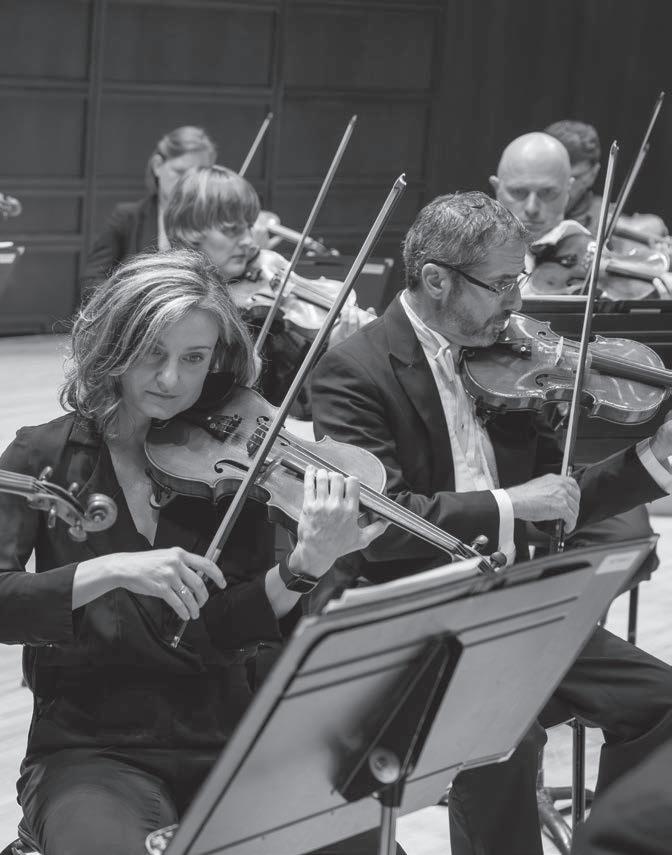
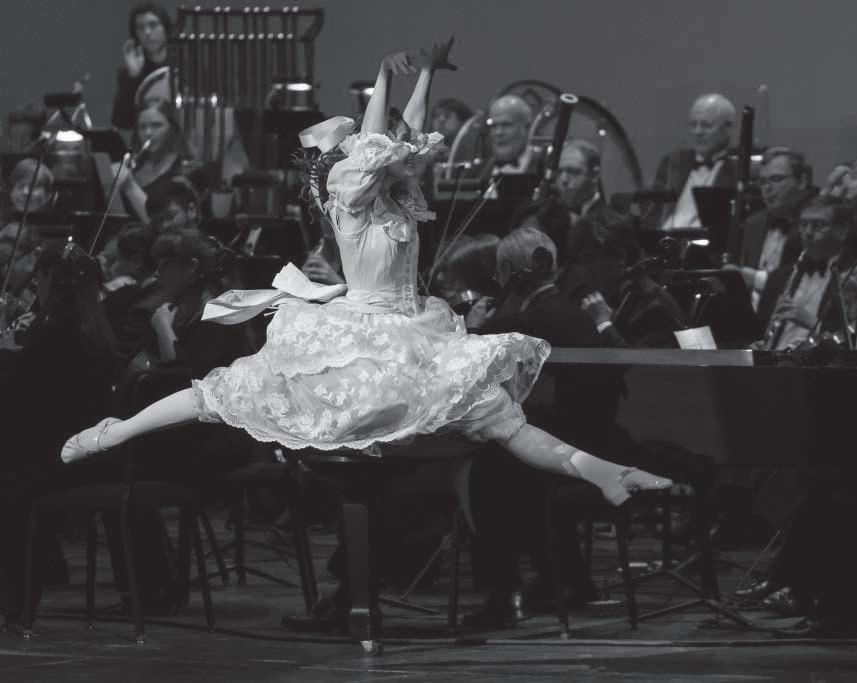

Author Biographies
Zadda Bazzy, Queens Creek Elementary School, Onslow County Schools, Swansboro, NC
Dr Zadda Bazzy brings over 25 years of experience to her role as the general music teacher at Queens Creek Elementary School in Swansboro, North Carolina . Dr . Bazzy holds a B F.A . in Musical Theatre, an M .A and a Ph .D . in Music Education, and a second M .A in Educational Leadership She has been certified by the National Board for Professional Teaching Standards since 2003 and has completed post-Level III certification in the Orff-Schulwerk approach to music education Beyond her classroom responsibilities, Dr . Bazzy is committed to professional development and has presented workshops for educators across the district and state . She is an active curriculum contributor, crafting lessons for the North Carolina Symphony’s Education Concerts and the Sarasota Orchestra’s Young Persons Concerts Dr Bazzy is dedicated to fostering future educators, serving as a mentor teacher and hosting music teacher interns from East Carolina University In recognition of her exceptional contributions, Dr . Bazzy received the North Carolina Symphony’s 2023 Maxine Swalin Award for Outstanding Music Educator She was also selected Teacher of the Year for Onslow County Schools in 2020 and for the School District of Manatee County, Florida, in 2013 .
Talia Cieri, West End Elementary School, Moore County Schools, West End, NC
Talia Cieri currently teaches general music at West End Elementary in Moore County She is a graduate of Methodist University in Fayetteville, North Carolina, where she was the drum major of the Marching Monarchs and flutist in the Fayetteville Symphonic Band and the Jazz Band . She was a member of The Chorale, the premier choral scholarship ensemble, as well as the octet, The Chamber Singers In 2015, she and the group shared their talents on a European tour, which included the Netherlands, Germany, Belgium, and France . She has served as a section leader and soloist with Brownson Memorial Presbyterian Church in Southern Pines She has completed Orff Level I and is looking forward to completing the next two levels to become fully certified Her primary instrument is the flute but she is also a ukulele and recorder enthusiast When she is not improvising silly songs and dances, she likes spending time with her husband and two dogs .
Amy Evers, Seawell Elementary School, Chapel HillCarrboro City Schools, Chapel Hill, NC
Born and raised in Miami, Florida, Amy Evers has over 22 years of experience as a music educator . Before her teaching career, Ms . Evers showcased her musical talents as a cabaret performer in South Florida, entertaining audiences on major cruise lines and at various venues She graduated with honors from Florida International University, earning a Bachelor of Science Degree in Music
Education with minors in Vocal Performance and Composition . Additionally, she holds National Board Certification in Early Childhood Music Ms Evers initially taught middle school chorus before transitioning to the elementary Level, where she currently serves as the music specialist at Seawell Elementary School in Chapel Hill . She is passionate about integrating music pedagogy with other content areas such as science, history, and particularly her students’ social and emotional learning Outside of work, she enjoys watching science-fiction movies and television, spending quality time with family and friends, and relaxing at home with her cat Tillie-Bug .
Amanda Hoke, Codington Elementary School, New Hanover County Schools, Wilmington, NC
Dr Amanda Hoke is the music teacher at Codington Elementary School in Wilmington, North Carolina She is a National Board and Kodály Certified Teacher, as well as the president of the North Carolina Kodály Educators Organization In 2019, Dr . Hoke was honored as one of the inaugural recipients of the NC Governor’s Discovery Award to pursue a professional development opportunity in literacy and music Apart from her role as an educator, Dr Hoke is an accomplished flutist, having performed extensively with orchestras across Florida, Tennessee, and North Carolina She is also known for her performances with the flute and guitar ensemble Cypress Duo and as principal flute of the City Ballet Orchestra in North Carolina She co-founded The Flute Examiner, a publication dedicated to flute and flute pedagogy In addition to a doctorate from Florida State University, she holds degrees from the University of Tennessee and the University of Louisville .
Amy Sullivan, Fuquay-Varina Elementary School, Wake County Public School System, Fuquay-Varina, NC
Amy Sullivan is the music teacher at Fuquay Varina Elementary School, with 16 years of experience in teaching elementary general music . She began her career teaching middle school general music, chorus, and advanced choral ensemble for five years before transitioning to elementary education Throughout her career, Ms Sullivan has fostered a love for music through various extracurricular activities, including choral and music theater, piano club, recorder karate, private vocal and piano tutoring, and percussion ensemble She has also served as department chair, lead mentor, and participated in numerous committees She is currently the District Three representative for the North Carolina Music Educators Association (NCMEA) However, her most cherished role is being a wife and mother to two wonderful children and a dog She resides in Willow Spring with her family, where they enjoy embarking on various life adventures and relaxing at home
Want to become an author for the North Carolina Symphony? Contact us! education@ncsymphony.org
introduction
Listen to all the different instruments!
Notice how the various elements of music—tempo, texture, dynamics, melody, rhythm, and form—come together to create a feeling of energy and motion
FEATURED WORK: African Suite , Op. 35, No. 4
Samuel Coleridge-Taylor’s African Suite, Op 35, No 4 is a lively and vibrant piece of music that captures the spirit and energy of African rhythms and melodies Written for orchestra, it features catchy tunes and dynamic rhythms that create an exhilarating and joyous atmosphere The piece reflects Coleridge-Taylor’s ability to blend Western classical music with African musical elements, showcasing his unique compositional voice and celebrating his African heritage . African Suite, Op 35, No . 4 remains one of his most popular and frequently performed works
Samuel ColeridgeTaylor
BORN: August 15, 1875, Holborn, England
DIED: September 1, 1912, Surrey, England
BIOGRAPHY (in Student Book)
Samuel Coleridge-Taylor was born in London to an English mother and a father from the West African country of Sierra Leone . He was musically gifted from an early age and studied at the Royal College of Music beginning at age 15 Originally a violinist, ColeridgeTaylor also wrote orchestral, piano, choral, and operatic works which were popular enough to take him on tour throughout the United States . He even received a White House invitation from President Theodore Roosevelt in 1904
Coleridge-Taylor’s music draws heavily on the African rhythms, melodies, and folk songs of his father’s side of the family His most famous work, The Song of Hiawatha, a set of choral pieces based on an epic poem by Longfellow, won him worldwide acclaim and received yearly performances in London from 1918-1939 Even though he died young, at the age of 37, his music is still played and loved by many people today . He is remembered for his beautiful compositions and for showing how music can bring different cultures together
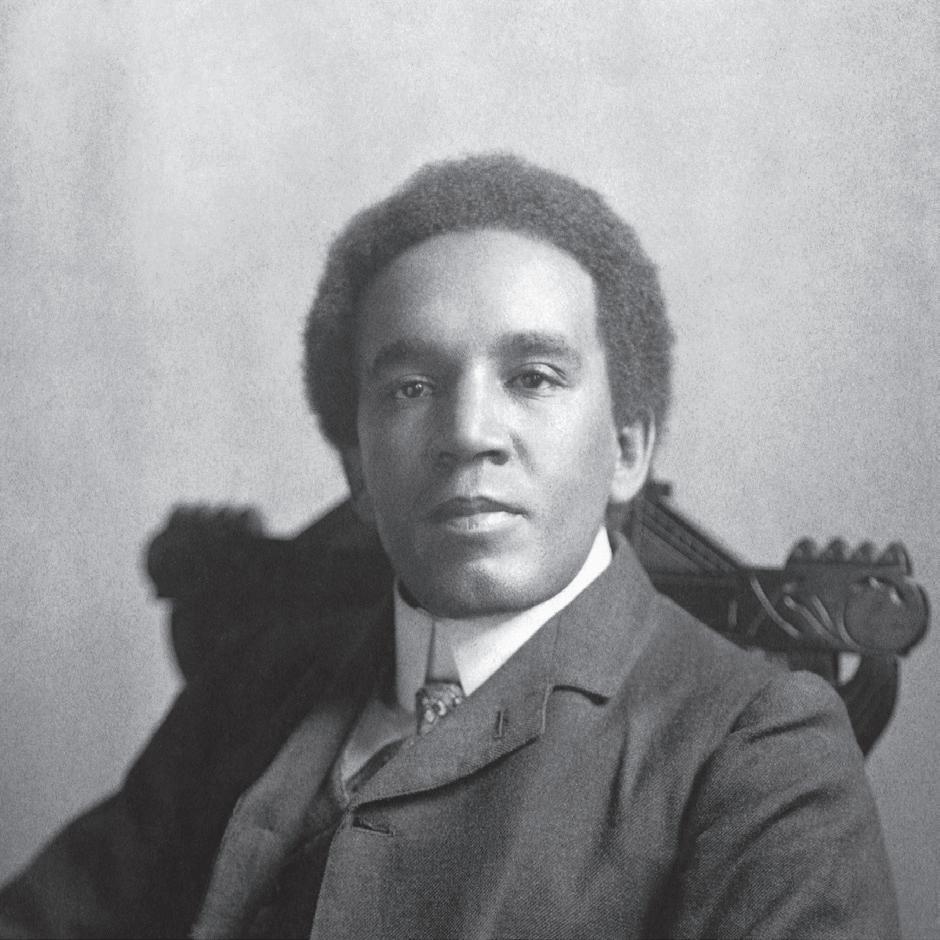
FUN FACTS about Samuel ColeridgeTaylor (in Student Book)
• Coleridge-Taylor’s hometown of Croydon voted on its three most famous residents to honor statues in the town square, and he won the vote!
• His American tour was so successful that public schools in Maryland and Kentucky were named after him
• Critics called the premiere of the first cantata in The Song of Hiawatha “one of the most remarkable events in modern English musical history ”
Classroom activities provided by Zadda Bazzy, Queens Creek Elementary School, Onslow County
CLASSROOM ACTIVITY #1: What Would You Do?
NORTH CAROLINA ESSENTIAL STANDARDS IN MUSIC:
4 CR .1 .2 Understand the relationships between music and concepts from other areas .
OBJECTIVE: Students will demonstrate an understanding of the significance of Coleridge-Taylor’s impact and reflect on how they can make a difference in their lifetime as well
MATERIALS:
• PowerPoint: About Samuel Coleridge-Taylor
PROCESS:
1 Share details about the life of Samuel Coleridge-Taylor using this PowerPoint .
2 Explain the significance of his work Coleridge-Taylor was famous within his lifetime In fact, he became famous as a person of color despite the widespread racism of the time Coleridge-Taylor used his success to bring light to injustices in the world He fought against racism . His influence extends beyond music to the area of social justice .
3 Invite students to relate to the life of Coleridge-Taylor by posing this discussion prompt in the PowerPoint:
Imagine you are successful—even famous—during your lifetime. Perhaps you end up as a famous musician, athlete, politician, actor, scientist, author, or social media influencer.
• How could you use your success to make a difference in the world?
• Would you influence others in a positive way?
• What sorts of issues would you draw attention to and why?
4 Students talk in groups of two or three
5 Reconvene the whole group and have several students share out .
6 NOTE: This activity aligns with Element IIb of the North Carolina Teacher Evaluation Process . Click here for more details – See page 3, Element IIb .
CLASSROOM ACTIVITY #2: Move to the Music
NORTH CAROLINA ESSENTIAL STANDARDS IN MUSIC:
4 MR 1 1 Illustrate perceptual skills by moving to, answering questions about, and describing aural examples of music of various styles and cultures
OBJECTIVE: Students will use a parachute and streamers to respond to musical elements that are presented aurally MATERIALS:
• Audio Recording with Voiceover Cues
•Parachute
•Streamers
PROCESS:
1 Explain that Samuel Coleridge-Taylor’s African Suite, Op . 35, No . 4 will be the Introduction piece at the concert For this activity, students will listen to the entire piece holistically and respond to many of the musical elements using a parachute and streamers .
2 To minimize confusion, this movement activity simplifies the form as follows: ABCDECA Coda The movements for each section are:
• A – Washing Machine – Holding the parachute at waist level with both hands, all students move their arms side to side with the half note pulse This movement mimics the agitator of a washing machine
• B – Up – Holding the parachute with both hands, students move the parachute from the floor up towards the ceiling and back towards the floor when the melody leaps to a high pitch The audio track with voiceover will cue when this happens
• C – Walk – Holding the parachute at waist level, all students walk counter-clockwise Keep the parachute taut .
• D – Colors – Holding the parachute overhead, the teacher calls for groups of students to go under the parachute and come out on the other side . This may align with the color they are holding on the parachute .
• E – Streamers – Students place the parachute on the floor and get a streamer Students “dance” (or move, but the title of the piece is African Dance) in a counterclockwise pathway around the parachute No one steps on the parachute . As the E section comes to a close, students place their streamer down again and return to holding the parachute on the ground .
• Coda – Perform the washing machine 4 times, then shake the parachute 12 times, then quickly lower the parachute to the floor
3 Practice the movements a cappella before adding the audio track To set up, have the parachute in the center of the room Place streamers in a large circle around the parachute Have all students stand at the parachute, holding it at waist level with two hands Both hands should be on the same color Display the following so the teacher and students know what will happen next (The students will not need the timings, but they may be helpful to the teacher ) NOTE: Spaces in the timings denote a time of transition; no active movements take place outside of the timings listed below .
Timing Section Movement
0:07-0:33
0:33-0:57 B
1:00-1:20 C Walk
1:24-1:49 D
Groups go under (by color, when called by the teacher)
2:04-3:18 E Streamers
3:28-3:51 C Walk
3:51-3:58 A
4:14-end Coda
Washing machine 5 times
Washing machine 4 times
Shake 12 times
Lower to the floor quickly
4 After moving to the audio track, collect the parachute and streamers
5 Debrief with students Which movements matched an element of music? Answers may include, but not be limited to:
• Different movements showed the form of the song .
• Lifting the parachute up matched the contour of the melody .
• Moving arms side to side for the washing machine pattern showed the beat
• The speed of walking and/or moving the arms matched the tempo
• The improvised movement of the streamers matched the dynamics, articulation, expression, etc
CLASSROOM ACTIVITY #3: Stick Dance
NORTH CAROLINA ESSENTIAL STANDARDS IN MUSIC:
4 .ML .1 1 Apply expressive qualities when singing or playing a varied repertoire of music representing genres and styles from diverse cultures
4 .MR .1 .1 Illustrate perceptual skills by moving to, answering questions about, and describing aural examples of music of various styles and cultures .
OBJECTIVE: Students will use sticks to perform a rhythm and improvise movements to match the music while listening to Samuel Coleridge-Taylor’s African Suite, Op 35, No 4
MATERIALS:
• Audio Recording with Voiceover Cues
• One pair of rhythm sticks per student
PROCESS:
1 Explain that Samuel Coleridge-Taylor’s African Suite, Op 35, No 4 will be the Introduction piece at the concert For this activity, students will listen to the entire piece and perform using rhythm sticks
2 Select approximately three students to help the teacher model the stick pattern Sit in a small circle and give a pair of rhythm sticks to the students who are modeling
3 . Teach the following pattern:

Description:
• Floor, Floor – Strike the floor with both sticks twice
• Play my sticks – Perform the rhythm by striking your sticks together
• Floor, Floor – Strike the floor with both sticks twice
• Side Side – Hold your left stick vertically at approximately shoulder level; at the same time, look to the right and strike your right stick against the stick of the person who is sitting next to you in the circle (on your right) two times
• Sticks – Strike your sticks together one time
4 . Set students up for success:
• It is helpful for the students to speak the words while they perform the action, especially when they are first learning the pattern Eventually they can whisper the words or silently mouth the words so they can hear the music while they perform with the audio
• In order to stay safe and be successful, students need to look to their right on “Side Side . ” Their left stick is simply creating a target for the person next to them; they don’t need to look to the left Focus on the stick of the person to your right and gently (musically) play against their stick
• Try this a cappella; add the audio later .
5 . After modeling the stick pattern with a small group, have the class sit in one large circle . Pass out rhythm sticks to each student . Practice the stick pattern as a whole group a cappella . Eventually this activity is performed in small groups, but for now practice as one large group
6 . There are times in the music where the stick pattern does not match the music At these times, students will take turns being leaders by silently “dancing” (improvising movements) with their rhythm sticks while they remain seated . The other students in their group copy the leader’s stick movements The voiceover will cue when it is time for the next student to lead the stick dance
• The teacher should model for the students by improvising silent stick dance movements; the students copy the teacher
• Prepare students for the coda At the end, all students may improvise stick dance movements simultaneously – there is no leader Then students perform the rhythm pattern 1 time . Finally, students shake their sticks silently and quickly, then extend both arms up overhead on the final chord .
• Assign students to groups . Five students per group is ideal, but groups as small as three students will work . Each student in the group is assigned a number 1-5 If there are less than five students in the group, some students will need more than one number .
7 . Perform with the audio track that has the voiceover cues . Sometimes students will be asked to perform the stick pattern Other times the voiceover will cue which student (such as Student #2) should lead the silent stick dance improvisation while the other students copy the leader’s movements . The voiceover will also cue the coda For your reference, the voiceover cues will occur as follows:
• Pause
• Rhythm pattern – 7 times
• Pause
• Rhythm pattern – 1 time
• Pause
• Rhythm pattern – 3 times
• Pause
• Student #1 improvises the stick dance
• Student #2 improvises the stick dance
• Student #3 improvises the stick dance
• Student #4 improvises the stick dance
• Student #5 improvises the stick dance
• Rhythm pattern – 1 time
• Pause
• Coda:
• All improvise a stick dance simultaneously
• Rhythm pattern – 1 time
• Shake sticks
• Arms up
8 . After performing, collect the rhythm sticks .
9 Have groups self-evaluate Small groups discuss and use a fist of five (fingers) to rate their performance Discussion prompts may include:
• Was the group able to perform the stick pattern correctly?
• Did the group perform at the correct tempo?
• Did the group perform at a dynamic level quiet enough that they could hear the music?
• Were students safe when they played their neighbor’s stick?
• Were the stick dance improvisations silent?
• Did the stick dance improvisations match what was heard in the music?
dynamics
The softness or loudness of the sound
Dynamics in music refers to the volume of the composition The words are often written in Italian Some of the most common are piano (p), soft; pianissimo (pp), very soft; mezzo-piano (mp), moderately soft; mezzo-forte (mf), moderately loud; forte (f), loud; and fortissimo (ff), very loud
FEATURED WORK: Symphony No. 4 in B-flat Major, Op. 60, I. Adagio-Allegro vivace
The first movement of Beethoven’s Symphony No . 4 begins with a mysterious and suspenseful Adagio introduction . This slow, brooding section creates an air of anticipation before launching into the lively Allegro vivace . The main section is characterized by brisk rhythms, playful melodies, and dynamic contrasts, reflecting Beethoven’s mastery of orchestration . The movement’s exuberant and joyful spirit is balanced with moments of lyrical beauty, making it a captivating and engaging opening to the symphony
Ludwig van Beethoven
BORN: December 1770, Bonn, Germany
DIED: March 26, 1827, Vienna, Austria
BIOGRAPHY (in Student Book)
The great German composer Ludwig van Beethoven transformed Western music—writing amazing symphonies, piano works, and string quartets—by connecting the Classical and Romantic musical periods He grew up in a broken home, but his remarkable skills at the piano earned him the chance to study with composer Joseph Haydn in Vienna at the age of 18 Soon, he impressed audiences with a performance and composition style that was more emotional, aggressive, and passionate than any musician that had come before . Beethoven’s output is divided into three broad categories . His early works (1785-1800) are exciting and joyful . However, Beethoven began to go deaf at the end of this period, which inspired greater emotional depth in his music His middle works (1800-1815) are among his most famous pieces, including his Symphony No 3 and Symphony No 5, marking the beginning of the Romantic period . Beethoven’s late period (1815-1827) consists of works often mysterious and experimental, such as his Symphony No . 9 and the late string quartets . Even though he was completely deaf by this time, his music continued to be powerful and express deep emotions
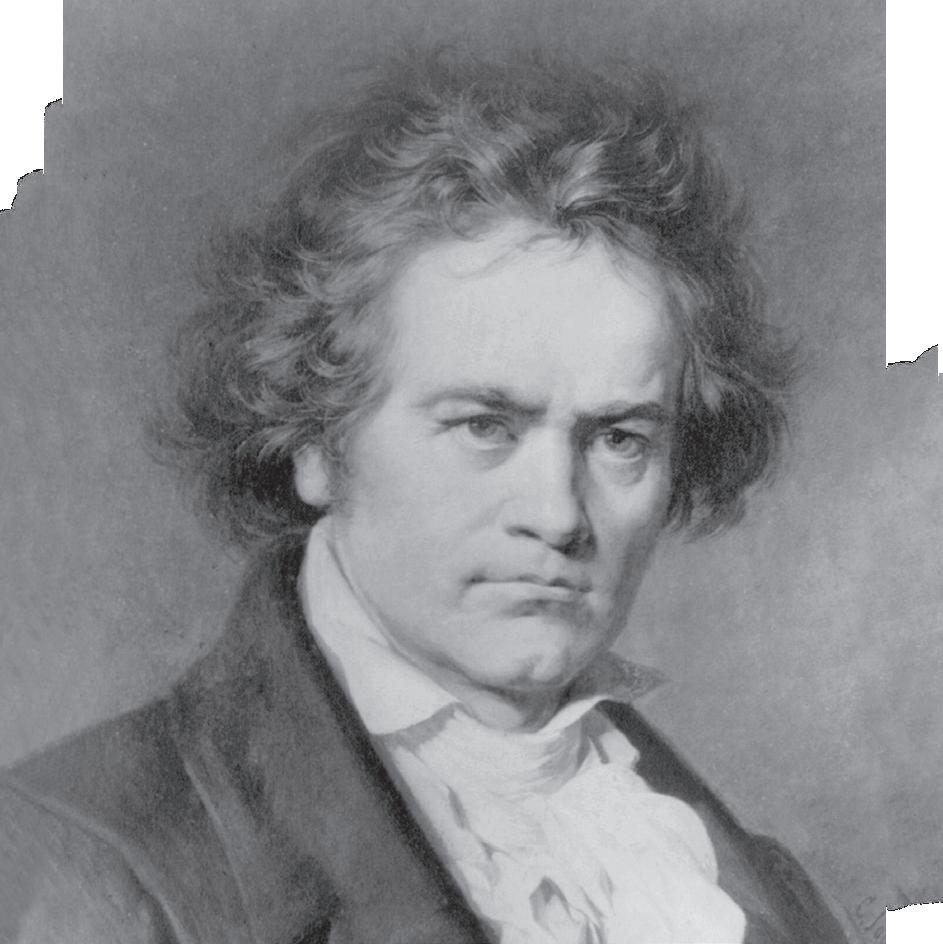
FUN FACTS about Ludwig van Beethoven (in Student Book)
• Beethoven’s favorite foods were macaroni and cheese, red herrings, and bread and egg soup .
• He was very fond of nature and often took long walks in the countryside to find inspiration .
• More than 20,000 people lined the streets of Vienna for Beethoven’s funeral procession .
CLASSROOM ACTIVITY #1: Dynamic Movement!
NORTH CAROLINA ESSENTIAL STANDARDS IN MUSIC:
3 .MR .1 .2 Use musical terminology when describing music that is presented aurally
3 ML 2 3 Recognize standard symbols and traditional terms for dynamics, tempo, and articulation
4 .MR .1 .1 Illustrate perceptual skills by moving to, answering questions about, and describing aural examples of music of various styles and cultures .
5 MR 1 2 Use music terminology in explaining music, including notation, instruments, voices, and performances
OBJECTIVE: Students will explore dynamics through guided movement
MATERIALS:
• Video Recording: Beethoven Symphony No . 4 in B-flat Major, Op . 60
• Colorful scarves (you can use your hands)
• Dynamic Signs
PROCESS: Non-locomotor
1 Pass out scarves
2 . Play Video Recording: Beethoven Symphony No . 4 in B-flat Major, Op . 60
3 Keeping the scarves in both hands, use the scarves to show how the volume increases and decreases When the scarf is small in your hands, the sound is small, etc .
4 Show students the different dynamic levels and how they relate to the size of the scarf You may first want to introduce the terms Soft – Medium – Loud, and then assign the Italian markings
Locomotor
1 . Assign different areas in the classroom to a dynamic level . Mark each area with a dynamic sign .
• Teacher tip: For this activity, it is best to stick to a few descriptive words or Italian markings For example: p, mf, f, ff or quiet (soft), medium, loud, very loud You may want to introduce descriptive words first and then traditional dynamic markings in Italian Your assigned areas can be a spectrum with two points or in different but related areas of the classroom
2 Play recording of the Video Recording: Beethoven Symphony No 4 in B-flat Major, Op 60
3 . As the recording plays, students move to different areas based on what they hear
CLASSROOM ACTIVITY #2: What do you hear? Dynamic 4 Corners!
NORTH CAROLINA ESSENTIAL STANDARDS IN MUSIC:
3 MR 1 2 Use musical terminology when describing music that is presented aurally
3 .ML .2 3 Recognize standard symbols and traditional terms for dynamics, tempo, and articulation .
3 .ML .1 1 Apply elemental changes, including changes to dynamics, tempo, timbre, or texture, when singing or playing music .
4 MR 1 1 Illustrate perceptual skills by moving to, answering questions about, and describing aural examples of music of various styles and cultures .
4 ML 2 3 Interpret standard symbols and traditional terms for dynamics, tempo, and articulation while performing music
4 .ML .1 1 Apply expressive qualities when singing or playing a varied repertoire of music representing genres and styles from diverse cultures
5 .MR .1 .2 Use music terminology in explaining music, including notation, instruments, voices, and performances .
5 ML 2 3 Apply understanding of standard symbols and traditional terms for dynamics, tempo, articulation, rhythm, meter, and pitch when reading and notating music
OBJECTIVE: Students will practice identifying different dynamics in a game of 4 corners .
MATERIALS:
• Dynamic Signs
• Material for the person calling: known songs, instruments, poems, etc
PROCESS:
Four corners is a simple game that most students love to play . One “traditional” way to play is as follows: One student is chosen to “call” a number while hiding their eyes The remaining students choose a corner in the room, each corner labeled with a number (1,2,3,4 etc .) . The “it” student calls a number . The students in that corner will sit down . This continues until one corner, or student, is left standing
1 . Assign each corner a dynamic .
2 Teacher tip: For this game, it is best to use the Italian markings p, mf, f, ff If you are using descriptive language, you may use quiet (soft), medium, loud, very loud Feel free to print and use these Dynamic Signs .
3 Either using song literature from your classroom, your speaking voice, or a non-pitched percussion instrument, give students who are performing the “call” a prompt to sing a section of a song, speak a phrase of a chant/poem, or play an instrument in a specific dynamic Teacher tip: to use this activity as an assessment, you can write out prompt cards with dynamic level to hand students to read before they call
4 . Once the student makes the call in a specific dynamic, that corresponding corner is out .
5 Play until only two corners or two students are left Teacher Tip: To expedite the game or to ensure everyone is included (for behavior management), once a corner is called, students who are out can join another corner The corner that is “out” is no longer an option, thus there will be only three rounds per game For example, if the student calling sings/speaks/plays an instrument at a forte dynamic level, the students in that corner can join another corner, but the forte corner is no longer an option for all students to join .

Classroom Extension Activity - Jumping Rice!
NORTH CAROLINA ESSENTIAL STANDARDS IN SCIENCE:
3 .P 1 .1 Infer changes in speed or direction resulting from forces acting on an object .
4 .P 3 .1 Recognize the basic forms of energy (light, sound, heat, electrical, and magnetic) as the ability to cause motion or create change
5 P 1 4 Predict the effect of a given force or a change in mass on the motion of an object
NORTH CAROLINA ESSENTIAL STANDARDS IN MUSIC
3 MR 1 2 Use musical terminology when describing music that is presented aurally
3 .CR .1 .2 Understand the relationships between music and concepts from other areas .
4 CR 1 2 Understand the relationships between music and concepts from other areas
5 .CR .1 .2 Understand the relationships between music and concepts from other areas .
OBJECTIVE: Students will experiment with different sounds at varying dynamic levels to understand basic sound production .
MATERIALS:
• Small bowl
• Uncooked rice or sprinkles
• Plastic wrap
• Rubber band
• Variety of different pitched and non-pitched percussion instruments
• Tuning fork (optional)
PROCESS:
To prepare: Take a small bowl and cover it tightly with plastic wrap To secure, you can place a rubber band around the bowl Place a small amount of uncooked rice on top of the plastic wrap This process can be seen here Choose 1-2 non-pitched/pitched percussion instruments of varying sizes for students to experiment
Teacher tip: This activity can be done as a centers activity . You can set up several bowls, or even have the students prepare materials!
1 . Demonstrate the jumping rice for students:
• Take the prepared bowl Strike the tuning fork (or another instrument) then hold it near the rice and watch it dance!
• Teacher tip: If your students have not seen a tuning fork, you may want to show them how it works by allowing them to hear it You can simply strike the tuning fork and hold it to their ear, or strike it and then place it on a wooden surface allowing the fork to ring
2 . Ask students to predict how much the rice will jump for 1-2 different instruments of ranging sizes at different dynamic levels You can have students write down predictions, and then test Or, you may want to do this as a whole group activity
3 . Using musical terminology, ask students why instruments played very loud (fortissimo) or very soft (pianissimo), make the rice jump even more [the louder dynamic causes more intense/louder sound waves, therefore causing the rice to move more]
rhythm
A pattern of notes of varied lengths and accents . . . the beat or the pulse of the music
“Rhythm” refers to placement of sounds as they move through time, usually forming a pattern . Every change in the pattern is a new rhythm .
FEATURED WORK: Chokfi’
Jerod Tate’s Chokfi’ is a vibrant and dynamic work for orchestra that draws inspiration from Native American folklore, specifically the mischievous trickster rabbit, Chokfi’ The piece is characterized by lively rhythms, playful melodies, and bold, energetic orchestration . Tate skillfully blends traditional Native American musical elements with contemporary classical techniques, creating a unique and captivating soundscape Chokfi’ reflects Tate’s dedication to celebrating and preserving his Chickasaw heritage through music, offering listeners an engaging and culturally rich experience
Jerod Impichchaachaaha’ Tate
BORN: July 25, 1968, Norman, Oklahoma
BIOGRAPHY (in Student Book)
Jerod Impichchaachaaha’ Tate is a Chickasaw classical pianist and composer Born in Oklahoma, Tate grew up surrounded by music His mother was a classical pianist, and his father was a Chickasaw tribal leader, so he experienced a mix of traditional Native American culture and classical music from a young age Tate was the founding composition instructor for the Chickasaw Summer Arts Academy and has taught composition to Native American students in several American and Canadian communities
Tate started playing the piano when he was very young and later studied music at the Cleveland Institute of Music He became a composer, writing music that blends classical styles with Native American themes and stories His compositions often include traditional Native American instruments and melodies, making his music unique and special
Tate expresses his native culture through his compositions, in the form of ballet, opera, and symphonic music . He has worked with the language of other Native American tribes besides the Chickasaw, including the Navajo, Cherokee, and Creek . Tate has been commissioned to compose pieces for many North American orchestras and organizations, and his music is performed worldwide

FUN FACTS about Jerod Impichchaachaaha’ Tate (in Student Book)
• Tate’s middle name, Impichchaachaaha’, is his inherited traditional Chickasaw house name and means “their high corncrib ”
• He has received many awards for his music, including being honored by the Oklahoma Music Hall of Fame and the Governor’s Arts Award . His work is celebrated for its creativity and cultural importance
• He released an album, Lowak Shoppala’ (Fire and Light), which depicts different scenes from Chickasaw history and parts of Chickasaw culture .
Classroom activities provided by Zadda Bazzy, Queens Creek Elementary School, Onslow County
CLASSROOM ACTIVITY #1: What’s the Meter?
NORTH CAROLINA ESSENTIAL STANDARDS IN MUSIC:
4 .ML .2 1 Interpret rhythm patterns, including whole, half, dotted half, quarter, and eighth notes and rests in 2/4, 3/4, and 4/4 meter signatures .
4 ML 2 4 Use standard symbols to notate rhythm, meter, and dynamics in simple patterns
OBJECTIVE: Students will demonstrate an understanding of meter by using their bodies to create groups which represent the meter they hear aurally Students will transfer this understanding to standard time signature symbols on an exit slip
MATERIALS:
• Rhythm cards/visuals
• Keyboard or piano
• Sticky notes
• Pencils
PROCESS:
1 Define rhythm and explain the relationship between rhythm and beat Rhythms include longer and shorter notes and rests The length of the note/rest is described in terms of the steady pulse of the music, or the beat Offer examples, such as a whole note lasts four beats, a half rest lasts two beats, etc .
2 Lead students in reading rhythm patterns written in standard notation Include rhythms in 2/4, 3/4, and 4/4
3 . Direct students to notice the time signature The top number tells how the beats are grouped . This is called the meter .
4 Model conducting patterns in 2/4, 3/4, and 4/4 time Have students copy the teacher’s conducting pattern
5 . Play the Meter Game:
• Formation: Students stand, scattered around the room .
• The teacher uses a keyboard or piano to play a simple pattern in 2/4, 3/4 or 4/4 time Emphasize beat 1 to make it easy to determine the meter Note: You do not need to be proficient on the piano to play a simple pattern Consider playing a I chord in root position . Play the tonic with the left hand on beat 1, followed by the third and fifth scale degrees on the right hand for the remaining beats of the measure Repeat . At the end of each round, change the key when you play the next meter .
Example:

• Students listen and silently determine the meter
• Once students know the meter (or on the teacher’s cue—your choice), students move around the room and group themselves to match the meter For example: if the meter is 4/4, students stand in groups of four If any students are not in a group of four, they sit down
• This is an elimination game . Continue changing the meter and playing the game until only two students remain .
• Set students up for success:
• Prior to playing the game, establish expectations Students may verbally invite students to join their group, but they cannot grab, drag, or otherwise force students to join their group
• Prepare students that this is an elimination game . Only two students will remain at the end . Although
everyone likes to “win,” most students will be eliminated . Remind students that the game is just for fun and there is no prize for winning If students are unkind to others during the game, the game must end .
• NOTE: There will be a teachable moment when there are 12 students left in the game . No students will be eliminated when there are 12 students if you use the meters 2/4 (six groups of two), 3/4 (four groups of three), or 4/4 (three groups of four) Try all three meters; students will probably notice that no one is being eliminated . Pause the game and tell students to sit on the floor right where they are for a moment Ask students why no one is being eliminated (The number 12 is divisible by 2, and 3, and 4 with no remainder, so no one is left out That is to say, in math terms, the numbers 2, 3, and 4 are all factors of 12 ) What’s the solution? Have students stand up and resume the game using a meter of 5/4 .
6 Prior to the end of class, check for understanding with a brief formative assessment Pass out sticky notes and pencils Use the keyboard/piano to play a few examples of the meters the students studied today Students write the time signature of the meter they hear and turn in their exit slip
CLASSROOM ACTIVITY #2: Playing Instruments: Micro/Macro Beat
NORTH CAROLINA ESSENTIAL STANDARDS IN MUSIC:
4 ML 1 1 Apply expressive qualities when singing or playing a varied repertoire of music representing genres and styles from diverse cultures
OBJECTIVE: Students will play instruments to the beat while they listen to Tate’s Chokfi’ .
MATERIALS:
• Score: Chokfi’
• Video Recording: Chokfi’
• Quiet instruments (sand blocks, small maracas, and/or egg shakers)
PROCESS:
1 Define rhythm and explain the relationship between rhythm and beat
2 Explain the concept of micro beat versus macro beat—the small beat versus the big beat When keeping the beat to a piece of music, one can perform the beat to a shorter duration (such as the eighth note pulse) or one can perform the beat to a longer duration (such as the quarter note pulse) Model this by performing the micro and macro beats to a song the students have studied recently
3 Share the following composer’s note from the score: “Chokfi’ is the Chickasaw word for rabbit, who is an important trickster legend within Southeast American Indian cultures ” According to one source, the Trickster Rabbit is “generally a light-hearted character who does not engage in serious wrongdoing” and “is prone to humorously inappropriate behavior”
4 Optional: Share an American Indian folktale or two about the Trickster Rabbit . Although Chokfi’ is the Chickasaw word for rabbit, other native tribes have different names for the same character Below are two folktales, but there are plenty more:
• Rabbit’s Snow Dance
• Rabbit’s Song
5 Tate’s subtitle for the piece is “Sarcasm for String Orchestra and Percussion ” Ask students to predict how a piece of music can be sarcastic
6 Show students the first page of the score . See if students notice what is unusual about the score (There are more than 20 time signatures on the first page alone .)
7 Explain that most music has one time signature for the entire piece . Some pieces include a change in meter, but Tate’s piece has an atypical number of meter changes When the meter changes throughout a piece it is called mixed meter . This gives the piece an unsettled and unpredictable feel when it comes to rhythm . It’s tricky, like the Trickster Rabbit! The micro beat will act as a sort of glue that holds the piece together as the meter changes over and over again
8 Tell students to silently keep the beat somewhere on their body while they watch the first 1:07 minutes of the piece .
9 Select approximately 5-7 students Give each student two small maracas (or two egg shakers) Play the video again until 0:56 Have the small group of students perform the micro beat (eighth note pulse) on their maracas/shakers while the rest of the class continues to keep the beat silently . The microbeat is performed on a maraca in the video . Rotate the instruments to a new group of students and repeat . Once all students have had an opportunity to play the micro beat on instruments, collect the maracas/shakers .
10 . Select a small group of students to perform the macro beat (quarter note pulse) on sand blocks while the rest of the class keep the micro beat silently while watching the video .
11 . Combine the macro beat and the micro beat: Give a small group of students the sand blocks and give all other students two small maracas or egg shakers . Have the sand block group perform the macro beat while the maracas/ shakers perform the micro beat while watching the video . Remind students to match the dynamic level of the music . Play quietly so we can hear your North Carolina Symphony!
12 . Collect the instruments
13 Conclude with an ending review of beat, rhythm, and meter Invite students to discuss what makes Tate’s Chokfi’ an accurate depiction of the Trickster Rabbit character who is known for causing trouble in American Indian folklore (The mixed meter gives the piece an unsettled, unpredictable, complex, playful, and mischievous sound . This matches the Trickster Rabbit character )

CLASSROOM EXTENSION ACTIVITY: Meter Math
NORTH CAROLINA ESSENTIAL STANDARDS IN MUSIC AND MATH:
5 ML 2 3 Apply understanding of standard symbols and traditional terms for dynamics, tempo, articulation, rhythm, meter, and pitch when reading and notating music
5 .NF.1 Add and subtract fractions, including mixed numbers, with unlike denominators using related fractions: halves, fourths and eighth; thirds, sixths, and twelfths; fifths, tenths, and hundredths
OBJECTIVE: Students will demonstrate an understanding of the common pulse in mixed meter by converting time signatures to related fractions with the same denominator .
MATERIALS:
• Score: Chokfi’
• Worksheet: Meter Math
• Pencils
PROCESS:
1 Explain what time signatures are The top number shows how many beats are in each measure The bottom number shows what type of note/rest gets one beat
2 Show students the first page of the score for Tate’s Chokfi’ Have students count the number of time signatures they see
3 . Tate’s Chokfi’ is written in mixed meter . This means the time signature changes throughout the piece .
4 To perform a piece in mixed meter, the conductor and musicians must have a sense of the micro beat (small pulse) that is consistent across time signatures . This requires musicians to understand the relationship between various time signatures It is the same skill a mathematician uses to convert fractions with unlike denominators into related fractions .
• Related fractions are fractions in which one denominator is a multiple of the other, e .g ., halves, fourths, and eighths . For more information, visit page 13 of NCDPI’s unpacking document .
5 Model how to covert related fractions For example:
• The first two time signatures of Chokfi’ are 2/4 and 3/8 . To find the micro beat, we can treat the time signatures like fractions and find a common denominator .
• If we multiply 2/4 by 2/2 (the equivalent of one whole), we convert the first time signature to 4/8 . There will be four eighth notes in this first measure
• This can also be shown with pictures, such as: Two of the four parts are shaded, or 2/4
Four of the eight parts are shaded, or 4/8
The same amount of the picture is shaded in both examples . They are equivalent fractions .
• Ask students to come up with another equivalent, such as 1/2 or 8/16 . Invite a student to the board to draw a picture of it Examples are below: 1/2
8/16
6 How many eighth notes would be in the first two measures of Chokfi’? We can determine this with the following equation:
2/4 + 3/8 = ?
To add these fractions, we must convert the 2/4 to its equivalent of 4/8 .
Then we can rewrite the equation as:
4/8 + 3/8 = ?
Now that the fractions have common denominators, we can add the numerators as follows: 4/8 + 3/8 = 7/8
The answer is that there will be 7 eighth notes in the first two measures of Chokfi’
7 Review with students how to convert an improper fraction (where the numerator is greater than the denominator) to a mixed number
Example: 9/8 = 1 1/8
8 . Review with students how to simplify fractions .
Example: 6/8 can be simplified to 3/4 Similarly, 2/4 can be simplified to 1/2
9 . Review that any fraction with the same number in the numerator and the denominator is equal to one whole .
Example: 4/4 = 1
10 Use the Music Math worksheet to give students an opportunity to practice adding fractions with unlike denominators using related fractions If this math skill is too advanced for students to do independently, the teacher may allow students to work in pairs or small groups For additional support, the Music Math worksheet can be projected onto the board and completed in a whole group setting with the teacher’s assistance . The answers to the worksheet are:
A 2/4 + 3/8 = 4/8 + 3/8 = 7/8
B . 2/8 + 2/4 = 2/8 + 4/8 = 6/8 = 3/4
C . 3/4 + 2/8 = 6/8 + 2/8 = 8/8 = 1
D 3/8 + 3/4 = 3/8 + 6/8 = 9/8 = 1 1/8
E 4/4 + 3/8 = 8/8 + 3/8 = 11/8 = 1 3/8
F 2/8 + 4/4 =
2/8 + 8/8 = 10/8 = 1 2/8 = 1 ¼
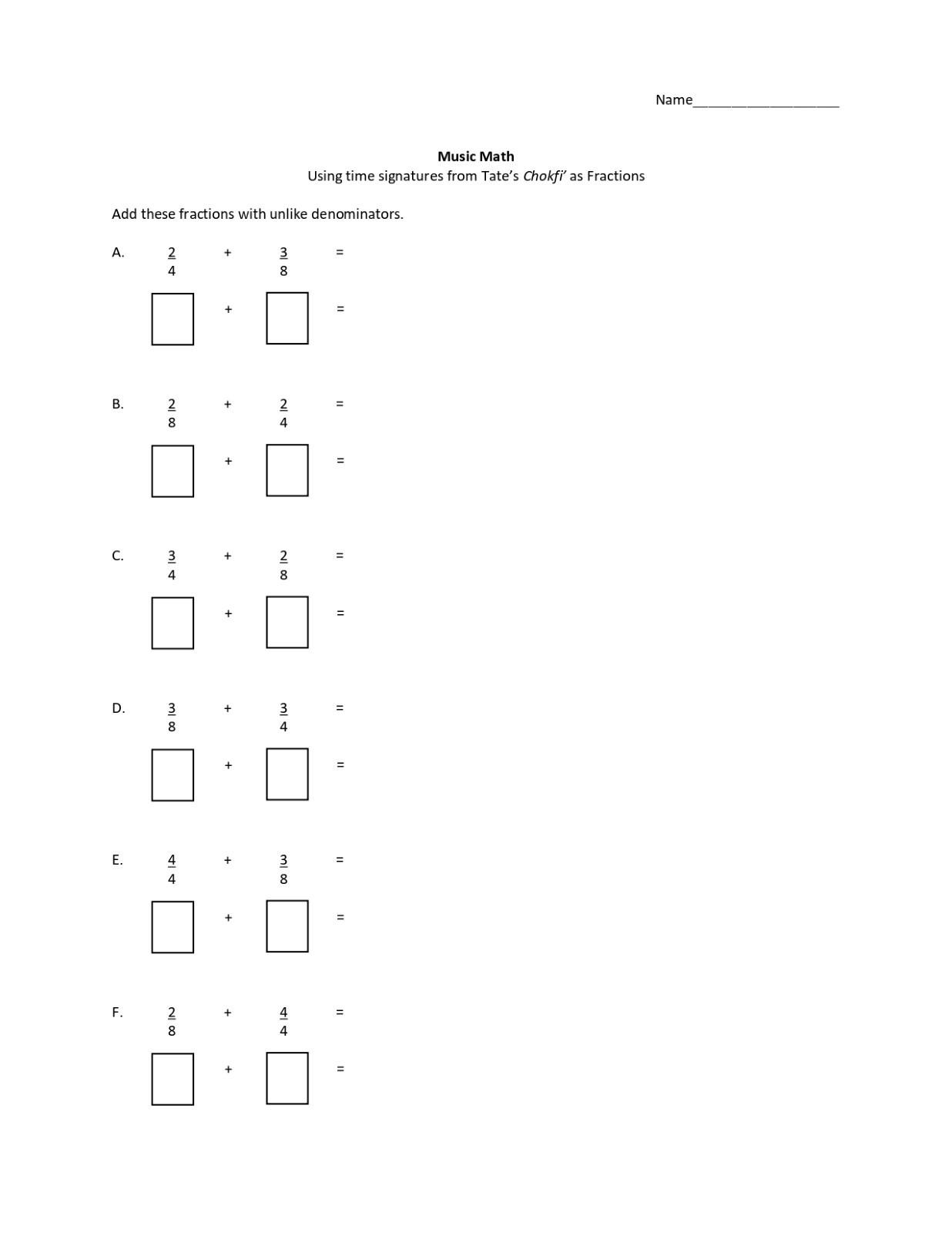
form
How the sections of music are put together . . .the structure
Form can be described as the map, layout, or blueprint for the music’s structure It is the overall organizational plan the composer creates, dividing the composition into sections arranged in a specific order
FEATURED WORK: Waltz from The Sleeping Beauty Suite
The Waltz from Pyotr Ilyich Tchaikovsky’s ballet The Sleeping Beauty is a delightful and iconic piece that captures the elegance and charm of a royal court dance It has become a staple in classical music repertoire and is often performed in concert halls and featured in films and media The Waltz exudes elegance and sophistication, evoking the atmosphere of a royal ballroom dance The music flows gracefully, with sweeping melodies and rhythmic patterns that invite listeners to imagine dancers gliding across the floor . Its enduring popularity lies in its melodic beauty, captivating rhythms, and Tchaikovsky’s masterful orchestration .
Pyotr Ilyich Tchaikovsky
BORN: April 25, 1840, Kamsko-Votkinsk, Russia
DIED: October 25, 1893, Saint Petersburg, Russia
BIOGRAPHY (in Student Book)
Pyotr Ilyich Tchaikovsky was a Russian composer born in Kamsko-Votkinsk, a small industrial town in Russia He was interested in music from a very young age, writing his own compositions and beginning piano lessons at the age of five However, his parents wanted him to choose a more stable career, so Tchaikovsky followed their wishes, going to boarding school at the age of ten and later pursuing an administrative job
In 1862, Tchaikovsky quit his job and became a full-time student at the St . Petersburg Conservatory, studying under famous musicians such as Nikolay Zaremba and Anton Rubenstein After his graduation, he went to teach music theory at the Moscow Conservatory, but found the job difficult, as he was also pressuring himself to compose at the same time . Tchaikovsky retired from teaching and wrote many more concertos, symphonies, and ballets .
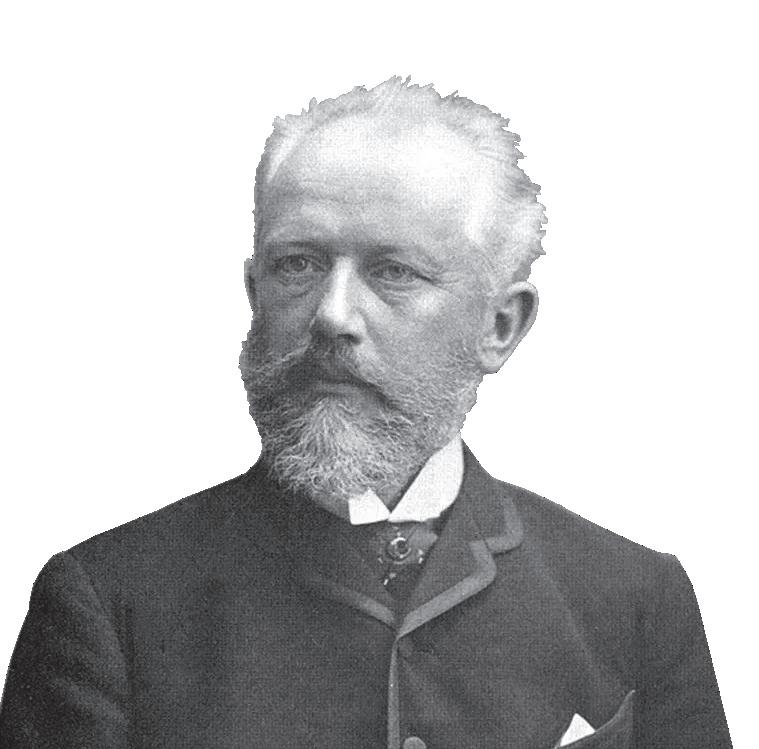
FUN FACTS about Pyotr Ilyich Tchaikovsky (in Student Book)
• Tchaikovsky’s favorite ballet he composed was The Sleeping Beauty, written in 1889
• He is perhaps most famous for his ballets, including The Nutcracker, Swan Lake, and The Sleeping Beauty.
• Tchaikovsky could read Russian, French, and German by the age of six!
CLASSROOM ACTIVITY #1: Rondo Form Movements
NORTH CAROLINA ESSENTIAL STANDARDS IN MUSIC:
2MR1 .2 Illustrate melodic patterns, dynamics, and forms .
4MR1 1 Illustrate perceptual skills by moving to, answering questions about, and describing aural examples of music of various styles and cultures
4MR1 .2 Explain personal preferences for specific musical works and styles, using appropriate music terminology .
4CR1 2 Understand the relationships between music and concepts from other areas
OBJECTIVE: Students will listen to Tchaikovsky’s Waltz from The Sleeping Beauty Suite and respond in pairs/small groups about what they hear Students will recognize and illustrate the form in music using movement activities
MATERIALS:
• Video Recording: Waltz from The Sleeping Beauty Suite
• Music response worksheet
• Writing utensils
• Listening Guide
• Parachute, beach balls or balloons (you can also use scarves/plastic grocery bags and balloons/beachballs),
• Listening Map
PROCESS:
1 . Introduce that waltzes are dance music in 3/4 time
2 Have students stand and move on the strong beat 1 You could also play time tag if time allows
3 . Pass out a listening guide and pencil/dry erase markers .
Teacher Tip: Laminate these or put them in plastic pouches to save paper
4 . Listen to the Waltz from The Sleeping Beauty Suite while responding to what students hear .
5 . Complete a mingle activity to share your responses with others .
Example: Find one partner or make a group of 3 to share your responses to the first question in the listening guide
6 . When the teacher says “mingle,” find a new group to share your responses to the second question . Continue “mingling” until students have shared all 6 responses from the listening guide .
7 . Teach students the 4 different parachute movements for the song
• On the Introduction and Conclusion, place several balloons or beach balls in the center of the parachute
• Students should rustle the parachute very quickly to try to bounce the balls off of the parachute . If using scarves, students should rustle the scarves as quickly as possible .
• During the A section, students should sway right, left, right, left, then arms up and down . If using a scarf, they can throw it up in the air and catch it .
• During the B section, students should lightly toss the beach balls up in the air and catch them with the parachute OR keep it in the air with a few beach balls in a circle
• During the C section, students should “mushroom” the parachute They lift it up and then quickly step in and sit on the edges of the parachute to trap the air (example)
• If using scarves, hold scarves (like joining hands) and rotate in a circle .
8 Explain that the song is in a Sonata Rondo form: Introduction, A, B, A, transition (B), C, A, B, A, Conclusion
9 . Show the listening map .
10 Listen to the song using your parachute and beach balls or scarves and beach balls Move appropriately to each of the different sections of the Rondo
CLASSROOM ACTIVITY #2: Rondo Form Compositions
NORTH CAROLINA ESSENTIAL STANDARDS IN MUSIC:
4ML2 .1 Interpret rhythm patterns, including whole, half, dotted half, quarter, and eighth notes and rests in 2/4, 3/4, and 4/4 meter signatures .
4ML2 .4 Use standard symbols to notate rhythm, meter, and dynamics in simple patterns
4ML3 2 Create compositions and arrangements using a variety of traditional and non-traditional sound sources
4ML3 .3 Create rhythmic compositions which include the use of whole, dotted half, half and quarter notes; whole, half and quarter rests; and beamed eighth notes in duple and triple time and which are arranged using a variety of sound sources
4CR1 .2 Understand the relationships between music and concepts from other areas .
OBJECTIVE: Students will compose a 3/4 meter rhythm piece in Rondo Form Students will perform their compositions in small groups for the class
MATERIALS:
• Video Recording: Waltz from The Sleeping Beauty Suite
• Video: Rhythm Reading in 3/4 Time
• Composition Cards
• Dry erase boards
• Blank paper or rhythm manipulatives to use for composing
• Classroom percussion instruments (students’ choice) .
PROCESS:
1 . Remind students of 3/4 time used in the waltz by moving on the strong beat . You could pass out scarves to practice conducting or swaying on the downbeat .
2 . Use small percussion instruments (sticks, shakers, sound drums, et) or corpophones (body percussion) to play the rhythm read along
3 Review how to compose in 3/4 by using the composition cards as composition suggestions
4 . Instruct students to compose 3 different 4-measure rhythms in 3/4 time and organize these compositions in Sonata Rondo Form (ABACABA)
5 . Have small groups share their compositions for the class to play together .
EXTENSION: Have students complete the same activity using 3 simple melodies that they either know (nursery songs) or compose/create, depending on abilities

CLASSROOM EXTENSION ACTIVITY: 2-Dimensional Rondo Triangles
NORTH CAROLINA MATH STANDARD COURSE OF STUDY:
NC 4 .OA .5 Generate and analyze a number or shape pattern that follows a given rule .
NC 4 MD 6 Develop an understanding of angles and angle measurement
NC 4 .MD .6 Understand angles as geometric shapes that are formed wherever two rays share a common endpoint, and are measured in degrees .
NC 4 .MD .6 Measure and sketch angles in whole-number degrees using a protractor
NC 4 G 2 Classify quadrilaterals and triangles based on angle measure, side lengths, and the presence or absence of parallel or perpendicular lines
OBJECTIVE: Students will create a rondo form pattern by measuring the angles to build two-dimensional right, acute, and obtuse triangles
MATERIALS:
• Straws
• Playdough
• Scissors
• Protractors
• Website: Types of Triangles
• Video: Classification of Triangles
PROCESS:
1 Review that Sonata Rondo form is in the pattern ABACABA
2 . Students will review how to measure angles using a protractor to create 3 different types of triangles by angle: right, acute, and obtuse
3 . Students will use straws and playdough to build a sonata rondo form through a pattern of the different triangles
For example, if A is a right triangle, B is an acute triangle and C is an obtuse triangle, the pattern would look like this:

Teacher Tip: Students should use a protractor to help measure their angles and scissors may be used to cut the straws to the best length
tempo
The speed of the music . . .how fast or how slow
Form can be described as the map, layout, or blueprint for the music’s structure It is the overall organizational plan the composer creates, dividing the composition into sections arranged in a specific order
FEATURED WORK: “ Mariachitlán
Juan Pablo Contreras’s Mariachitlán is an exhilarating orchestral work that vividly captures the spirit and vibrancy of mariachi music The piece seamlessly blends traditional Mexican mariachi elements with contemporary orchestral textures, creating a lively and festive atmosphere Characterized by rhythmic drive, bold brass fanfares, and evocative melodies, Mariachitlán transports listeners to the heart of a bustling mariachi plaza . Contreras’s innovative composition celebrates Mexican cultural heritage while showcasing his unique voice as a modern composer, making it a captivating and dynamic addition to the orchestral repertoire .
Juan Pablo Contreras
BORN: 1987, Guadalajara, Mexico
BIOGRAPHY (in Student Book)
Born in Mexico in 1987, Juan Pablo Contreras is a Latin composer who works to incorporate Mexican folk music into classical orchestration He began playing the piano when he was very young and quickly fell in love with music He later studied music at the California Institute of the Arts and the Manhattan School of Music . His works have been performed around the world, and he is the youngest Mexican classical composer to be nominated for a Latin Grammy Award
In 2023, when Contreras received the Vilcek Prize for Creative Promise in Music, he said “By writing music that brings Latinx culture to the fore, I seek to inspire orchestras to diversify their programming and become more inclusive institutions . ” His works often include instruments like marimbas and mariachi bands, bringing the lively sounds of Mexico to the concert hall . Mariachitlán is one of his most famous pieces, celebrating the music and culture of his hometown
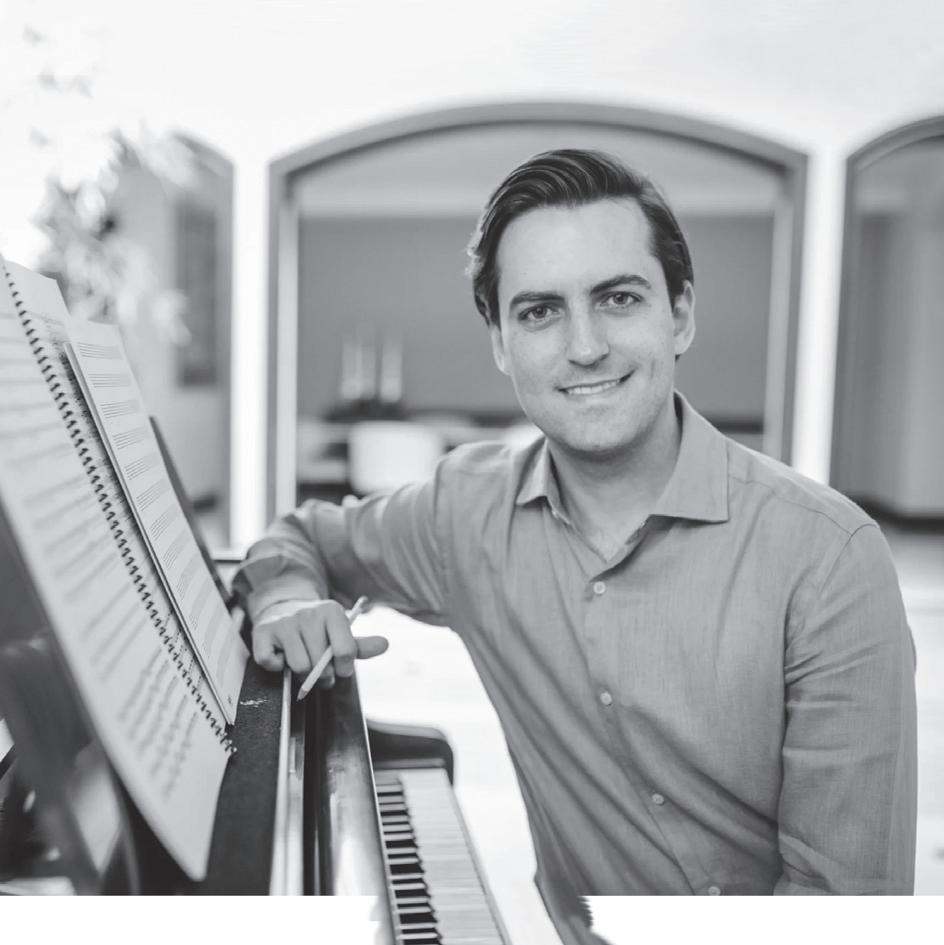
FUN FACTS about Juan Pablo Contreras (in Student Book)
• Contreras’s works have been performed by 40 major orchestras in the United States, Mexico, Austria, Slovakia, Colombia, Spain, Argentina, and Venezuela
• Contreras currently teaches orchestration and music theory at the University of Southern California
• His orchestral work, Lucha Libre! features six soloists that wear luchador masks; this piece is a nod towards Mexico’s wrestling culture .
Classroom activities provided by Talia Cieri, West End Elementary School, Moore County
CLASSROOM ACTIVITY #1: Tempo Tantrum!
NORTH CAROLINA ESSENTIAL STANDARDS IN MUSIC:
3 .ML .2 3 Recognize standard symbols and traditional terms for dynamics, tempo, and articulation .
4 ML 2 3 Interpret standard symbols and traditional terms for dynamics, tempo, and articulation while performing music
OBJECTIVE: Students will show understanding of tempo through singing and movement MATERIALS:
• Video: Tempo Chant
• Video Recording: Mariachitlán
• Video: Cabeza, Hombros, Rodillas y Pies (Head, Shoulders, Knees and Toes)
• Metronome or Online Metronome
• Four Corners Tempo Signs
• Cones (Optional)
• Speaker to play music outdoors (Optional)
PROCESS:
1 . Introduce or review the country of Mexico and mariachi music .
2 Define tempo: The speed of the beat
3 . Teach students the tempo chant or show the video
4 . Mariachitlán has many tempo changes . Discuss with students how most of the music they listen to likely has a consistent tempo Ask students:
• Why would music change tempo?
• Do you know of any music that switches between fast and slow tempos?
• “Pop Goes the Weasel”
• “Rattlin’ Bog”
5 . Teach “Head, Shoulders, Knees, and Toes” in Spanish Have students perform the song at different tempos while doing the movements .
6 . Introduce the tempo vocabulary—largo, adagio, andante, moderato, allegro, presto—and encourage students to think of real-life examples/activities (animals, objects, how they move at home and school) Example for a playground:
• Largo: Swinging on a swing
• Adagio: sneaking up on a friend, see-saw
• Andante: walking in line
• Moderato: monkey bars
• Allegro: jumping rope
• Presto: Sprinting or running away while playing tag
7 . Ask students how they know when it’s time to leave the playground . (The teacher calls out or sounds a whistle etc .)
8 Connect the story of Mariachitlán (meaning “Mariachi Land”) with the playground
“Are all the kids usually doing the same thing? (No, all these things can happen at once .) The different groups of kids playing on the playground are kind of like the different mariachis playing their songs trying to get the most attention from the crowd In the song, a policeman blows the whistle to stop the music, just like a teacher might whistle to stop your playground time ”
9 . Listen to Mariachitlán and allow students to signal each time tempo changes and a new mariachi is playing .
• Examples of signals are standing up and sitting down or raising a hand
• Encourage students to feel the speed of the beat through tapping, patting, or other quiet movement
10 . Four Corners Game: If you are not familiar with Four Corners, it is an elimination game where students are given a short time (usually 10 seconds) to move to a corner of a room . The corners are numbered 1-4 and all students should understand what corner has what number . One student, who is not looking, calls out a number between 1 and 4 and students in that corner are out This game can be modified in many ways
• Tempo Four Corners A .K .A Don’t have a Tempo Tantrum!
• For the purposes of this game, begin with the four corners as largo, andante, allegro, and presto You can put 4 signs up at four corners of the room (optional- number the signs as well) .
• Students begin at the center of the room Play students a clip from Mariachitlán where the tempo does not change As they listen, students should go to the corner that they believe has the correct tempo Encourage students to think for themselves instead of following where other students go
• Briefly ask students why they believe they have chosen the correct tempo . Tell them the answer and repeat with another clip
• This can be played as a stationary game as well, with students staying in one spot . Students can point to the corner or hold up 1-4 fingers to show their answer .
• To increase the challenge, you can add the other two tempos on one of the signs .
• This can be played as elimination and as an assessment I have found that playing this game as nonelimination first keeps students from following the crowd to avoid elimination, but playing elimination later adds a competitive factor, if your students are motivated by that!
• If time, space, and weather allows, this game can be played outside with cones or some other object used to mark and show the four corners Play music clips through a speaker if you have one!
CLASSROOM ACTIVITY #2: Tempo-rarily Tongue Twisted!
NORTH CAROLINA ESSENTIAL STANDARDS IN MUSIC:
3 .ML .1 1 Apply elemental changes, including changes to dynamics, tempo, timbre, or texture, when singing or playing music .
4 .ML .2 3 Interpret standard symbols and traditional terms for dynamics, tempo, and articulation while performing music .
OBJECTIVE: Students will show understanding of tempo through speaking, singing, and movement
MATERIALS:
• Metronome or Online Metronome
• English Tongue Twisters
• Spanish Tongue Twisters/Trabalenguas
• Video: Al Citrón Song Recording
• Video: Al Citrón stone passing example
• Stones or other small round objects
PROCESS:
1 . Review tempo terms . The Four Corners game from the previous lesson, played while seated, can be a great brain activator!
2 Teach the students tongue twisters in English Speak them at different tempos
3 Teach students tongue twisters in Spanish (trabalenguas)
4 . Discuss how speaking tongue twisters and learning about musical tempo helps students become better readers (enhances fluency: accuracy (correctly), quickly (not too slow or fast), with expression (not like a robot)
5 Tell the students we will play a game to combine a song from Mexico with keeping a steady beat at different tempos (“Al Citrón” is a stone passing children’s game from Mexico If you are familiar with “Obwisana” from Ghana, it is similar!)
• Play the “Al Citrón” recording for students and have them pat to show the beat . You should be able to hear the sound of the students tapping the stones on the ground in the recording .
• Teach the pronunciation of Al Citrón by rote .
• Teach the melody of Al Citrón phrase by phrase Have students pretend to “grab and pass” while they sing Passing can go to the right or the left Passing to the right will make the stones go counterclockwise If you choose to go the opposite way, follow the below directions but opposite .
• Have students sit in a circle facing inward Give each student one stone or other small round object Have students keep their stone in their hand, practice tapping the stone with the beat in front of them and to their right on the beat
• Add in grabbing and passing, which requires students to let go of the stone and grab the one placed in front of them by the person on their left
• This game can also be done with cup passing or anything that is small enough to be easily passed
6 Do the game at different tempos
7 . Optional: Students can compose a new passing game . Cups offers more creativity and complexity in terms of the passing routine
English Tongue Twister Examples
Unique New York
Red leather, yellow leather
Betty bought butter, but the butter was bitter, so Betty bought better butter to make the bitter butter better .
Peter Piper picked a peck of pickled peppers
A peck of pickled peppers Peter Piper picked .
If Peter Piper picked a peck of pickled peppers, where’s the peck of pickled peppers Peter Piper picked?
Spanish Tongue Twister Examples with Translation
Link for native speaker audio: https://llamitasspanish.com/trabalenguas-spanish-tongue-twisters-kids/
Mi mamá me mima mucho . My mom spoils me a lot.
Un perro rompe la rama del árbol
Gallo y grillo, gritan, gozan . Gritan, gozan, grillo y gallo
Pepe Pecas pica papas con un pico, con un pico pica papas Pepe Pecas
Al Citrón Pronunciation
The lyrics are nonsense except for citrón, which is a citrus fruit .
Al Citrón de un ahl see-TRONE deh OON fandango, Sango sango, fahn-DAHN-go SAHN-go SAHN-go
Sabare sabare sah-bah-REH sah-bah-REH
A dog breaks the tree’s stick.
Rooster and cricket, shout, have a great time. Shout, have a great time, cricket and rooster.
(This is the Spanish version of the popular ‘Peter Piper picked a pepper.’)
Joe Freckles chops potatoes with a pick, with a pick Joe Freckles chops a potato.
de la randela, deh lah rahn-DEH-lah
con su triki triki tron cone soo TREE-kee TREE-kee trone
texture
The overall sound of the instruments that are playing . . .it’s how the music feels
Texture is the aspect of music that describes how melody and harmony interact in a piece of music . There may be an instrument played alone or many parts played at the same time There may be a single melody supported by harmony, or multiple independent melodies being played by different instruments simultaneously, or in a call and response format . These compositional choices influence the mood or feeling of a piece of music A “thin” texture may be one instrument playing a simple melody A “thick” texture may be more than two instruments playing complex line together The texture usually becomes thicker or heavier when more instruments play together and when their parts are denser
FEATURED WORK: Symphony No. 94 in G Major, II. Andante
Joseph Haydn’s Symphony No 94 in G Major, commonly known as the “Surprise Symphony,” is one of his most famous and beloved works The second movement, marked Andante, is particularly noteworthy The symphony earned its nickname due to a sudden fortissimo chord in the second movement This unexpected loud chord (the “surprise”) interrupts the serene and gentle character of the Andante, startling the audience and adding a humorous element to the music . Listening to the piece offers a glimpse into the Classical era’s elegance and craftsmanship . It showcases Haydn’s ability to create music that is both is both intellectually engaging and emotionally resonant, making it a timeless favorite among audiences and musicians alike
Joseph Haydn
BORN: March 31, 1732, Rohrau, Austria
DIED: May 31, 1809, Vienna, Austria
BIOGRAPHY (in Student Book)
Born in Austria in 1732, Joseph Haydn was an important composer in the development of the forms and styles for symphonies and string quartets Demonstrating musical talent at a youthful age, Haydn became a choirboy at St Stephen’s Cathedral in Vienna, where he received a lot of his early musical training . After his voice changed and he could no longer sing in the choir, he started working as a musician and composer Haydn eventually became the court musician for the wealthy Esterházy family, where he wrote some of his most famous music He composed over 100 symphonies, 68 string quartets, and many other pieces for different instruments and voices Some of his most famous works include the “Surprise Symphony” and the “Emperor Quartet ” Haydn’s music is known for its lively and cheerful melodies, as well as its creativity and innovation, and continues to be loved and played all over the world .
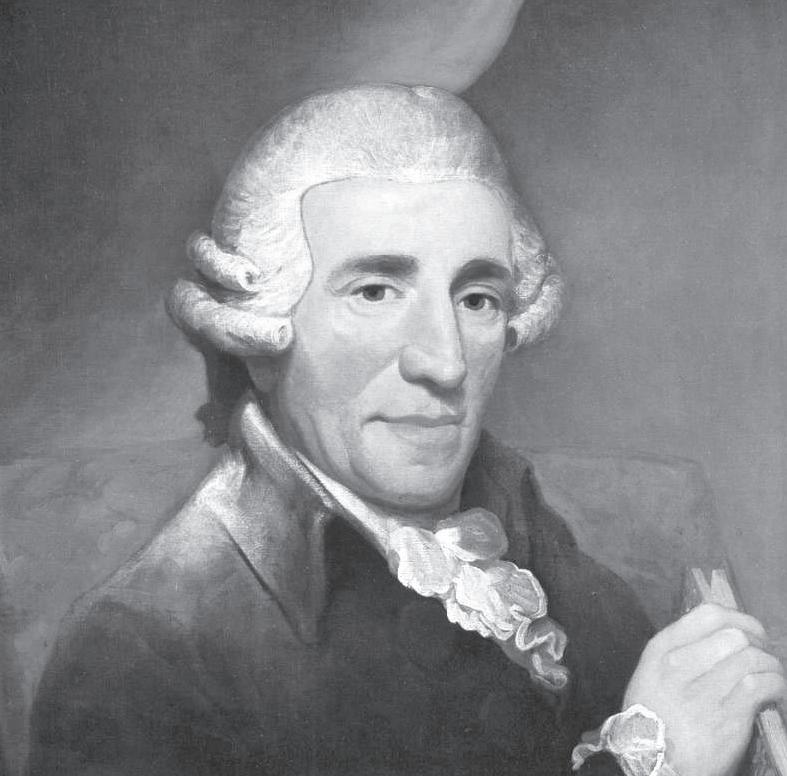
FUN FACTS about Joseph Haydn (in Student Book)
• Haydn had a great sense of humor and liked to play musical jokes In his “Farewell Symphony,” he made it so musicians would leave the stage one by one until only two violinists were left, surprising the audience .
• Haydn was a friend and mentor to both Mozart and Beethoven
• Joseph Haydn is often called the “Father of the Symphony” because he wrote over 100 symphonies and helped shape the symphony into what it is today .
Classroom activities provided by Amy Sullivan, Fuquay-Varina Elementary School, Wake County
CLASSROOM ACTIVITY #1: Rhythm Texture Experiments
NORTH CAROLINA ESSENTIAL STANDARDS IN MUSIC:
3ML1 .3 Use instruments to perform rhythmic and melodic patterns accurately and independently on classroom rhythmic and melodic instruments .
4ML3 3 Create rhythmic compositions which include the use of whole, dotted half, half and quarter notes; whole, half and quarter rests; and beamed eighth notes in duple and triple time and which are arranged using a variety of sound sources
4MR1 3 Design a set of criteria for evaluating music performances and compositions
OBJECTIVE: Students will differentiate between and create monorhythmic, homorhythmic and olyrhythmic compositions using percussion instruments .
MATERIALS:
• Video Recording: Symphony No 94 in G Major, II Andante
• Music Listening Response Sheet
• Classroom percussion instruments and/or body percussion
PROCESS:
1 Students will complete a listening sheet while listening to Haydn’s Surprise Symphony Andante
2 Students will learn that this piece is a theme and variations and that our focus will be on learning about different textures
3 . Explain that we will first experiment with rhythms and texture in small groups
4 . Break students into small groups and have each group create a short rhythmic pattern (4-8 beats) . Challenge students to experiment with playing alone, playing together and layering different sounds .
5 After the groups have had time to practice, each group will choose their favorite rhythm to share
6 As each group shares, determine if everyone in the group played the same rhythm or if people played different rhythms at the same time
7 . Experiment as a class with 2 or more different groups playing at the same time and layering the whole class with all of the different rhythms
8 . If time allows, ask students to compare and contrast the different rhythms shared by noticing if any groups created the same or incredibly similar rhythms versus rhythms that were dramatically different .
CLASSROOM ACTIVITY #2: Monophony, Homophony, or Polyphony?
NORTH CAROLINA ESSENTIAL STANDARDS IN MUSIC:
4ML1 .2 Execute the performance of vocal ostinatos, partner songs, counter-melodies, and rounds in two or more parts .
4ML1 3 Use voice and/or instruments to execute melodic movement through pentatonic melodies on the treble staff
4ML2 .2 Interpret through voice and/or instruments simple pitch notation in the treble clef in major keys .
3ML3 1 Use improvisation to create rhythmic and melodic ostinato accompaniments
OBJECTIVE: Students will use unison singing, rounds, and partner songs to learn the difference between monophony, homophony, and polyphony in music .
MATERIALS:
• Video Recording: Symphony No 94 in G Major, II Andante
• Video: Are You Sleeping?
• Video: Are You Sleeping & Row Your Boat
• Video: Row Your Boat with Rounds
• What is Texture in Music?
• Paper
• Crayons
PROCESS:
1 . First, students will review how to sing “Are You Sleeping” and “Row, Row, Row Your Boat ” Students will sing both songs in unison, a cappella .
2 . The teacher will point out that when we all sing the same thing at the same time, it is a monophonic texture, showing the texture chart .
3 . Next, the teacher will pass out C, E, or G boomwhackers, Orff instruments, recorders, and/or ukuleles
4 Half of the class will sing the melody, while the other half improvises using a C Major chord to accompany the song
5 The teacher will point out that when we sing with accompaniment, it is homophonic
6 . Next, we will try singing the two songs at the same time as partner songs This is one way to sing polyphonic texture .
7 . We will also try singing both songs in rounds to reinforce the polyphonic texture .
8 . Finally, using a piece of paper, students will create their own graphic representation of monophony, homophony and polyphony .

CLASSROOM ACTIVITY #3: Chrome Music Lab Textures
NORTH CAROLINA TECHNOLOGY STANDARDS- ISTE:
1 2 b Online Behavior: Students engage in positive, safe, legal and ethical behavior when using technology, including in social interactions online or when using networked devices
1 .2 c Intellectual Property: Students demonstrate an understanding of and respect for the rights and obligations of using and sharing intellectual property
1 .6 a Choose Platforms or Tools: Students choose the appropriate platforms and tools for meeting the desired objectives of their creation or communication .
1 .6 b Original and Remixed Works: Students create original works or responsibly repurpose or remix digital resources into new creations .
OBJECTIVE: Students will use Chrome Music Lab to create a monophonic, homophonic, and/or polyphonic melody
MATERIALS:
• Chromebooks or other device
• Headphones
• Samples of monophonic, homophonic, and polyphonic melodies
• Google form for sharing work samples
PROCESS:
1 Students will review the three different textures we have been studying: monophonic, homophonic, and polyphonic
2 . Students will listen to an example of a monophonic melody and be challenged to create their own .
• Monophonic Sample
• Students should save the song by copying and pasting the link in a Google Form to upload samples or use Canvas to submit links
3 . As students finish their monophonic melody, show them how they can create a homophonic melody by coloring 1-2 more blocks vertically to align with the original melody they saved
• Homophonic Sample 1
• Homophonic Sample 2
• Students should save the song by copying and pasting the link in a Google Form to upload samples or use Canvas to submit links
4 . If time allows, students may also try to compose a polyphonic melody
• Polyphonic (round)
• Polyphonic
• Students should save the song by copying and pasting the link in a Google Form to upload samples or use Canvas to submit links
CLASSROOM EXTENSION ACTIVITY
Share the Google Sheets of all the songs submitted in the Google Form and have students listen and respond to the different melodies composed by their classmates using a rubric or specific set of criteria .
melody
The main idea of the music . . .the line that you walk away singing
Melody is a sequence of individual notes that form a satisfying whole When harmony is added, the melody is the principal singing part In a choral environment, it can be tempting for singers to listen to the melodic line Harmony is quite important to the melody—it supports and balances the melody so that it can shine through as the easiest part to recognize
FEATURED WORK: “America the Beautiful”
“America the Beautiful” is a patriotic hymn that celebrates the natural beauty and unity of the United States . Written by Katharine Lee Bates in 1893, the lyrics vividly portray America’s landscapes, from spacious skies to amber waves of grain . Samuel Ward’s melody, known as “Materna,” complements the lyrics with its uplifting and majestic tone . The song has become an enduring symbol of American pride and spirit, often performed at national events and ceremonies to inspire a sense of unity and admiration for the country’s scenic wonders
Terry Mizesko
BORN: September 21, 1946, Morehead City, North Carolina
BIOGRAPHY (in Student Book)
The beloved song “America the Beautiful,” with music by Samuel A . Ward and music by Katharine Lee Bates, was arranged for the North Carolina Symphony by Terry Mizesko, who was bass trombonist for the Symphony from 1971–2017 He is a native of Morehead City, North Carolina, and a graduate of East Carolina University, where he studied composition and trombone He also appeared as guest conductor with the North Carolina Symphony and with the Charlotte Symphony Orchestra in educational concerts . He taught trombone for more than 20 years at several area schools including Duke University, UNC-Chapel Hill, and St . Augustine’s University He now devotes much of his time to composition and his family

FUN FACTS about Terry Mizesko (in Student Book)
• Terry Mizesko was the North Carolina Symphony’s bass trombonist for 46 years
• During his time with the North Carolina Symphony, he played for every music director except the founder, Lamar Stringfield
• The North Carolina Symphony has performed his compositions and orchestrations in classical, pops, and education concerts throughout the state
• He enjoys great art, good food, and spending time with his wife, who is a violist with the North Carolina Symphony, and their two children
Classroom activities provided by Amanda Hoke, Codington Elementary School, New Hanover County
CLASSROOM ACTIVITY #1: Melody Scramble
NORTH CAROLINA ESSENTIAL STANDARDS IN MUSIC:
3 .ML .2 1 Interpret rhythm patterns, including notes and rests in 3/4 and 4/4 meter signatures
3 MR 1 2 Use musical terminology when describing music that is presented aurally
4 .ML .2 1 Interpret rhythm patterns, including whole, half, dotted half, quarter, and eighth notes and rests in 2/4, 3/4, and 4/4 meter signatures .
4 ML 2 2 Interpret through voice and/or instruments simple pitch notation in the treble clef in major keys
5 ML 2 1 Interpret rhythm patterns, including whole, half, dotted half, quarter, dotted quarter, eighth, and sixteenth notes and rests in 2/4, 3/4, 4/4, and 6/8 meter signatures
5 .ML .2 2 Recognize pitches on the treble and bass staves, including ledger lines, in order to understand the continuum of standard pitch notation
OBJECTIVE: Students will learn the melody of “America the Beautiful” by exploring its rhythm, pitch, and melodic contour .
MATERIALS:
• Video Recording: “America the Beautiful”
• Vocal Score: America the Beautiful
• Melody/Lyrics Matching Cards
PROCESS:
1 Sing “America the Beautiful” for or with students
2 . Ask students to listen while you clap the rhythm while singing . Compare the rhythm of each of the four phrases of the first verse . Ask students what they notice (it’s the same for every phrase)
3 . Show the vocal score . Have students say or clap the rhythm using preferred rhythm syllables
4 Split the class into two groups Have one group tap the rhythm only while the other group sings the melody only Switch roles so the students tapping the rhythm are now singing
5 . Ask students: What does the pitch do? [It doesn’t stay the same like the rhythm, it changes with the text ]
6 Discuss melodic contour Show the vocal score and have students sing while tracing the pitch with their fingers As melody goes higher, the notation on staff goes higher as well . Point out key patterns for students, including the cadence at the end (rhythm and melodic), the chorus section, etc
Optional: Have students read the absolute pitch or solfege
7 . Explain that some of the melodic contour shows the meaning of the lyrics: text painting.
• For example, Phrase 2: The melodic leap on “A - bove,” uses pitch (from low to high) to describe the mountains towering above the fruited plains .
• Phrase 3: “A-mer-i-ca…” the large leap in melody and use of exclamation points in the lyrics show expansiveness, emphasis, and grandeur
8 Play the “America the Beautiful” Matching Game
• Have students work in 4 groups of 2-4 depending on size of class . If you have a large class, you can also split your class in half and have two rounds of the same matching game America the Beautiful Flash Cards
• 4 of the groups will have the staff notation (the red notecards) These students will find one spot in your classroom and stay there The other 4 groups will have the corresponding lyrics without the notation . These groups will move around the room trying to find the staff notation that matches their lyrics .
• Before you begin, remind students to use their knowledge of rhythm, melodic contour, and text painting to find their matching group .
• For an extra challenge, set a timer to see how long it takes for every group to be matched Once combined, there should only be 4 groups
• An optional final step is to “unscramble” the 4 groups in the order of the song . Have students stand with their groups, in order of the song, and sing their phrases as it appears in the song
CLASSROOM ACTIVITY #2: “America the Beautiful” Tableau
NORTH CAROLINA ESSENTIAL STANDARDS IN MUSIC:
3 .MR .1 .2
Use musical terminology when describing music that is presented aurally
4 MR 1 1 Illustrate perceptual skills by moving to, answering questions about, and describing aural examples of music of various styles and cultures .
5 MR 1 2 Use music terminology in explaining music, including notation, instruments, voices, and performances
OBJECTIVE: Students will use a tableau activity to strengthen their understanding of the melody of “America the Beautiful . ”
MATERIALS:
• Video Recording: “America the Beautiful”
• Vocal Score: America the Beautiful
• Tableau Note Cards
PROCESS:
This activity uses tableau, a comprehension teaching strategy where students create a “living picture” that communicates (without talking!) the meaning of a concept . Students will set a tableau to “America the Beautiful” by deconstructing the song’s expressive melodic elements and lyrics . Students will display the meaning of “America the Beautiful” by using physical poses, gestures, and facial expressions rather than communicating with words . Students should have a working knowledge of the “America the Beautiful” before starting this project . See Activity #1 to introduce or deepen understanding of the song .
1 Show vocal score Brainstorm the meaning in the lyrics of “America the Beautiful” and how they might be connected to the melody of the song Present the lyrics in 4 phrases You may need to review some of the terminology with students as it appears . Possible brainstorm responses may include:
• Phrase 2: The melodic leap on “A - bove,” an example of text painting, uses pitch (from low to high) to describe the mountains towering above the fruited plains
• Phrase 3: “A-mer-i-ca…” the large leap in melody and use of exclamation points in the lyrics show expansiveness, emphasis, and grandeur
2 . After brainstorming the meaning of each phrase, give possible ways to show meaning through body poses Example: Phrase 2: Have two students stand together, one student makes their body into a mountain standing over the other student as a plain
3 Create a tableau! Divide the class into 4 or 8 groups of 2-4 students each Smaller classes will have 4 groups and do the first verse only If you have a large class of over 16 students, you will have 8 groups and do both verses (4 phrases x 2 verses = 8 groups) Once your groups are established, assign each group a phrase of the song by passing out the tableau note cards . Make sure to place them in order in your classroom .
Optional: Use the Tableau Planning Template and have each group sketch out their ideas first
4 . Have students work together and set their own tableau for their phrase of “America the Beautiful . ” Set a timer for 5 minutes or less .
5 . Once the timer goes off, have students set the stage with their tableau . Play the recording of “America the Beautiful” and video record each group in order of appearance Watch the video with students!
Additional Resources for “America the Beautiful” https://www.npr.org/2019/04/04/709531017/america-the-beautiful-american-anthem https://www.dictionary.com/e/america-the-beautiful-lyrics-you-dont-know/


finale
All elements work together to form music!
Listen for all the elements of music, including tempo, rhythm, dynamics, form, texture, and melody
FEATURED WORK: Overture to William Tell
Gioachino Rossini’s Overture to William Tell is a dramatic and iconic piece that opens his final opera with grandeur and excitement It begins with a serene and pastoral theme representing the Swiss landscape, famously featuring the stirring “cavalry charge” that builds to a thunderous climax Known for its dynamic energy and masterful orchestration, the overture captures the heroic spirit and adventurous narrative of the opera Rossini’s use of orchestral color and rhythmic intensity makes it a standout example of 19th-century opera overtures, beloved for its evocative power and enduring popularity in concert halls worldwide
Gioachino Rossini
BORN: February 29, 1792, Pesaro, Italy
DIED: November 13, 1868, Paris, France
BIOGRAPHY (in Student Book)
Gioachino Rossini was one of the most significant Italian composers in the early 1800s and was primarily known for his 39 operas Born in Pesaro, Italy, Rossini grew up in a musical family; his father played the horn, and his mother was an opera singer . He showed a great talent for music from a young age, learning to play the piano and compose his own pieces
In 1802, his family moved to Lugo, and Rossini studied music with a local priest . He wrote his first opera when he was just 18 years old He quickly became very popular, writing many successful operas that were performed all over Europe Some of his most famous operas include The Barber of Seville, Cinderella, and William Tell . His music is known for its lively, catchy tunes and playful spirit . He retired from composing operas at the age of 37, but his music continues to be performed and enjoyed by people all over the world
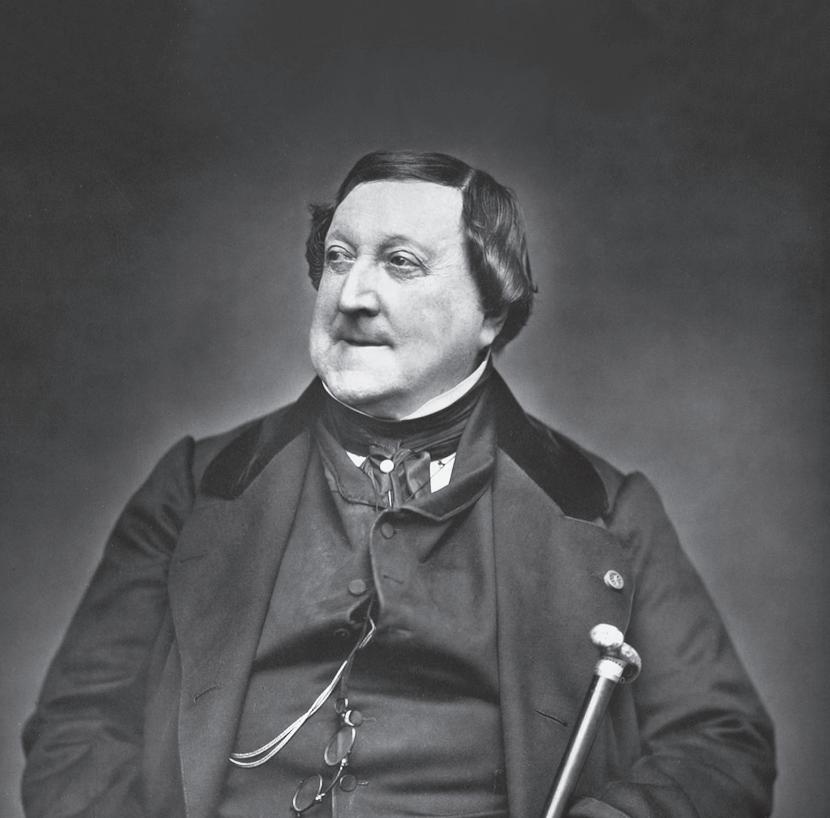
FUN FACTS about Gioachino Rossini (in Student Book)
• Rossini is most well-known for his William Tell overture, which has been used in many television shows and movies, such as The Lone Ranger and A Clockwork Orange
• He was known for composing music very quickly He wrote his famous opera The Barber of Seville in just two weeks!
• He had a habit of overusing the crescendo during his pieces, earning him the nickname “Monsieur Crescendo . ”
CLASSROOM ACTIVITY #1: The William Tell Overture Guided Listening with Movement
NORTH CAROLINA ESSENTIAL STANDARDS IN MUSIC:
3 .MR .1 .2 Use musical terminology when describing music that is presented aurally
3 MR 1 3 Use established criteria to evaluate music
4 .MR .1 .1 Illustrate perceptual skills by moving to, answering questions about, and describing aural examples of music of various styles and cultures
4MR 1 2 Explain personal preferences for specific musical works and styles, using appropriate music terminology .
5 MR 1 2 Use music terminology in explaining music, including notation, instruments, voices, and performances
OBJECTIVE: Students will learn that music has different sections and how these sections are arranged is known as “Form”; and that music has multiple elements that are combined to create each piece of music The elements of music include but are not limited to rhythm, melody, dynamics, and form They will listen to and respond to, through movement, the different sections in the William Tell Overture, and be able to describe rhythmic and dynamic changes using correct music terminology .
MATERIALS:
• Video Recording: Overture to William Tell
• Audio Recording or Play Along Video
• Choice Board: Overture to William Tell
• Colored Scarves
• Ribbons, Flashlights*, etc
*The flashlights should be small hand-held lights. They can be purchased at Wal-Mart or Amazon. You will then tint the lenses by coloring them with Sharpies or another type of permanent marker.
PROCESS:
Listen to the overture while showing the Form Map or Play-Along video that corresponds to the activity you choose below
GUIDED LISTENING/MOVEMENT ACTIVITY
Students are divided into three groups, each group representing three of the different sections of the William Tell Overture The “D” section, introduction, and interludes are reserved for the instructor Each group is given a different color scarf, ribbon, or other movement tool Students find their own movement space in the classroom It does not have to be with others in their group Students pose like statues in a statue garden or art gallery When the music plays, students can move or dance during their colors section . When their section of music has ended, they return to being frozen like a statue Encourage students to make their movements reflect what is happening musically . During the coda, all the colors can move together
Modification: Students who have mobility issues can sit in chairs and use only their upper bodies, or simply allow students to move to the best of their ability . Students who are colorblind can be prompted or given a scarf that is patterned .
GUIDED LISTENING/FLASHLIGHT ACTIVITY
Students are again divided into three groups, each group representing three of the different sections of the William Tell Overture The “D” section, introduction, and interludes are reserved for the instructor Students sit with flashlights pointing up at the ceiling and then match the melody of their section by “painting” with light During the coda, all the colors can “paint” together .
EXTENSION ACTIVITY
Create a drawing where students illustrate different sections of the overture based on what they think is happening in the story of William Tell during each section of the music
CLASSROOM ACTIVITY #2: The William Tell Overture Rhythm - Tap Along
NORTH CAROLINA ESSENTIAL STANDARDS IN MUSIC:
3 ML 1 3 Use instruments to perform rhythmic and melodic patterns accurately and independently on classroom rhythmic and melodic instruments
3 ML .2 1 Interpret rhythm patterns, including notes and rests in 3/4 and 4/4 meter signatures .
4 ML 2 1 Interpret rhythm patterns, including whole, half, dotted half, quarter, and eighth notes, and rests in 2/4, 3/4, and 4/4 meter signatures .
4 ML 2 4 Use standard symbols to notate rhythm, meter, and dynamics in simple patterns
5 ML .1 1 Illustrate independence and accuracy while singing and playing instruments within a group or ensemble ML 2 1 Interpret rhythm patterns, including whole, half, dotted half, quarter, and eighth notes, and rests in 2/4, 3/4, and 4/4 meter signatures .
OBJECTIVE: Students will learn, recognize, and perform a “Tap Along” to the rhythmic patterns using a printed guide for the William Tell Overture
MATERIALS:
•Video Recording: Overture to William Tell
•Video: Tap Along Rhythm Game
•Choice Board: Overture to William Tell
•Color Guide Visual
•Black and White printed guide
•Colored pencils
•Markers.
PROCESS:
1 . After listening to the overture 1 or 2 times, show the repeated rhythmic pattern of section 1 to the students (see below)

2 . Teach the students the pattern using rhythm syllables .
3 Show students the colored version of the Tap Along Guide (via Emanuele Ruggiero) and demonstrate how the notated rhythm “fits” with the guide
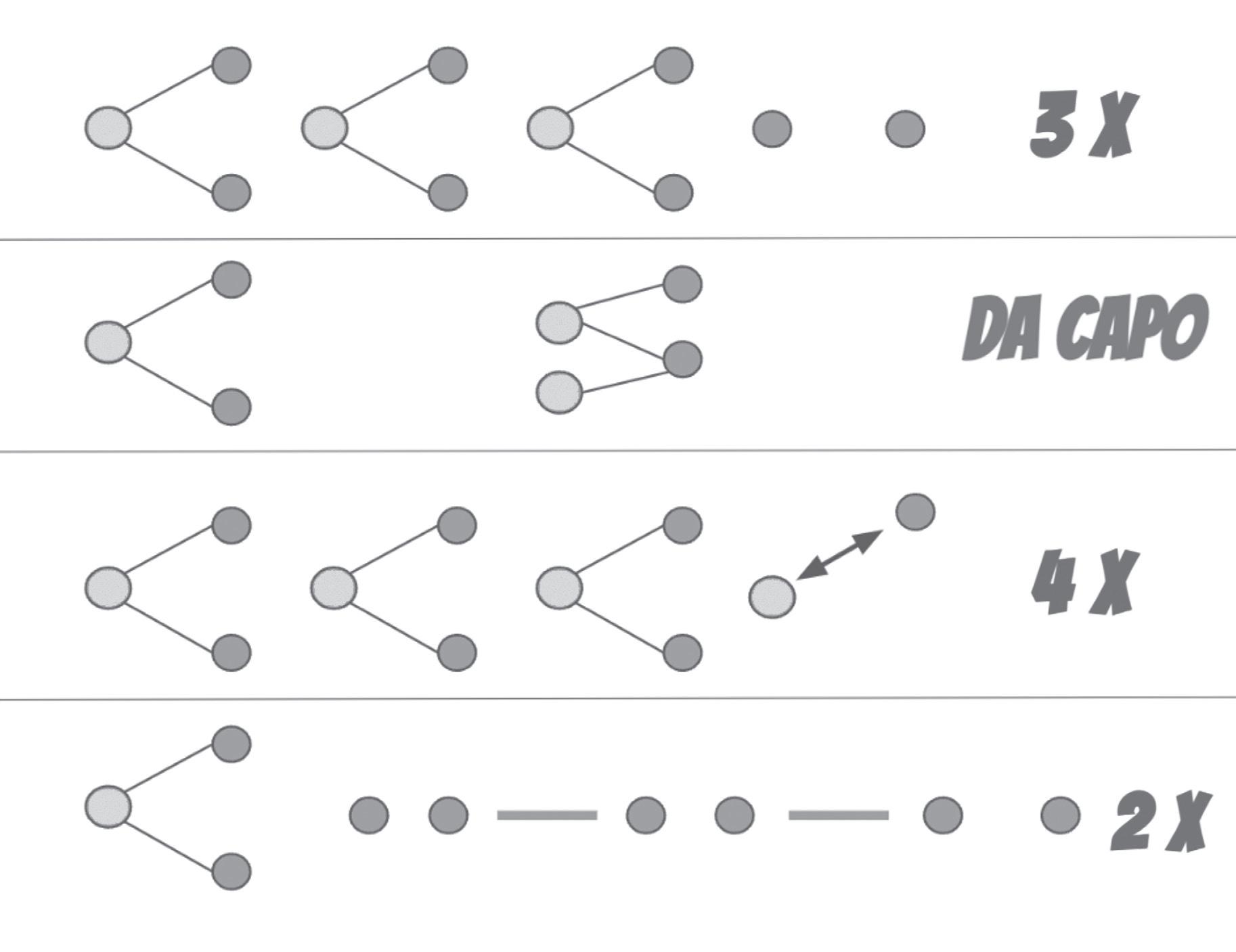
4 Hand out the blank Tap Along Guide and have students choose two different colored pencils or markers Markers and colored pencils are best as the students will also be using them as their “drumsticks” and crayons are too short
5 . Have the students color in their guide using the two colors they have chosen .
6 . Using the play-along video by Emanuele Ruggiero, (it begins with a fast version and has a slower version starting at 1 ‘12”), slowly guide the students through the process of tapping the rhythm patterns using the corresponding marker to the same-colored dot on the guide .
7 . Once they have mastered the patterns slowly, play the video or an audio recording of The William Tell Overture and have the students tap along a tempo .
EXTENSION ACTIVITY:
Have students match the standard notation patterns below to the visual patterns on the colored guide .
Section 1:




MODIFIED ACTIVITY
If you notice that a student is struggling with the rhythm tapping, try the Alternate Black and White Guide . It was created with left-handed students in mind Many “lefties” will be able to use the standard version, but this version may be helpful for any student who is struggling regardless of handedness

CLASSROOM ACTIVITY #3: Make Your Own Mini Crossbow
NORTH CAROLINA ESSENTIAL STANDARDS IN SCIENCE:
PS .3 .3
PS 4 1
PS .5 .2
Understand how energy can be transferred from one object to another
Understand how various forces affect the motion of an object
Understand force, motion, and the relationship between them
OBJECTIVE:
Students will create a miniature model of a Crossbow using clothes pins, rubber bands, and cotton swabs .
MATERIALS:
• Clothes Pins (Wood or Plastic)
• Rubber Bands
• Cotton Swabs (Q-Tips, etc )
• Choice Board: Overture to William Tell
PROCESS:
1 Each student gets one (1) clothespin, two (2) Cotton Swabs, and two (2) Rubber Bands (Fig 1)
2 . Remove the cotton from the swabs (Fig . 2)
3 Place one swab into the spiral of the clothespin’s spring (Fig 3)
4 . Wrap one of the rubber bands around the back of the clothespin and the cotton swab, not too tightly . (Figs 4, 5, 6)
5 . Wrap the second rubber band around the front of the clothespin, again not too tightly . (Fig . 7)
6 Using the rubber band that is wrapped around the back of the swab, stretch the top of the band and place it into the “mouth” of the pin (Fig 8)
7 . Open the pin and using the second swab (this is your arrow) push it gently against the interior rubber band as far as you can, and while still holding the swab close the pin shut . (Fig . 9)
8 . When you are ready, open the clothes pin and the tension created by the stretched rubber band is released this should make your “arrow” fly (Fig . 10 and video included on the Choice Board)
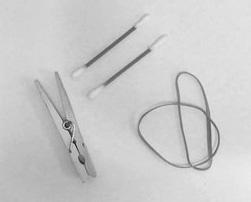
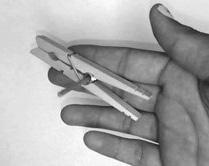
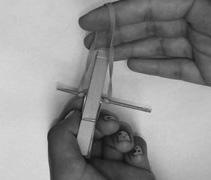

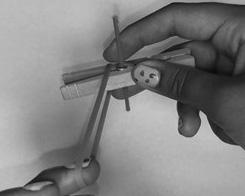
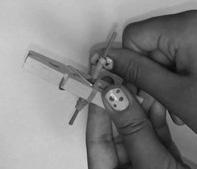
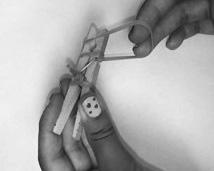
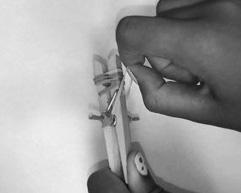
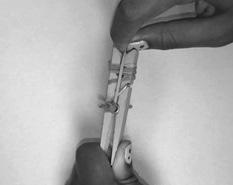
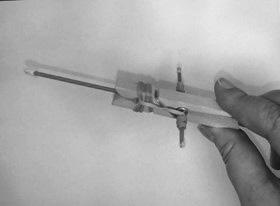
What Does the Conductor Do?
In the performance, it may look like the conductor is simply waving a wand from the Harry Potter movies in his or her hand as the orchestra plays the music . However, there is more to the job than waving a baton . The work of conductors usually starts months before the performance and can take a lot of time and study . They are responsible for:
A. Selecting the music
The selection of the music is based on the type of program the conductor would like to present to the audience . The program can be a collection of show tunes, a collection of works from one composer, or a program that is thematic—following some idea like Nature or Science Fiction . Music selection is also based on whether the orchestra currently owns the piece and has the right instruments to perform it
B. Preparing to rehearse
Once the music is selected, conductors will begin studying the music so they are ready to lead and rehearse the orchestra They usually do some analysis (looking at the details of the music) of the melody and the different instruments that present it, the harmony, and the structure—how the music is put together to present the idea the composer had when they wrote it . Conductors will look at the individual parts or at each line from each instrument to see if there are any difficult parts that may require more attention in rehearsal They will begin to establish an interpretation of the work…in other words, how fast or slow, the tone color to use, the dynamics to use in different sections, etc . Just as artists choose colors and brush styles to use in applying those colors to a painting, conductors use sound and how that sound is presented to paint their musical picture for the audience Conductors may listen to some recordings of other conductors/orchestras to hear how they performed the piece and then decide if they would like to perform it like they did or differently, creating their own interpretation Occasionally, conductors have the opportunity to look at copies or even the original of a score penned by the composer to see what the composer noted as far as the dynamics and the tempo settings .
C. Rehearsing the orchestra
Conductors will spend the most time rehearsing the orchestra . They watch the score as they listen to each of the sections/instruments play the parts and then they will stop and give the orchestra directions on how to play the music better Perhaps it should go faster here, or slower here, or maybe the strings need to be louder here because they have the melody and the conductor wants the audience to hear the melody more clearly . Conductors have the chance to stop the piece and correct a part of it during rehearsal .
D. Conducting the performance
During the performance, conductors visually reminds the orchestra of those things covered in rehearsal . They keep the group together by conducting the meter and the spirit of the piece, encouraging the musicians to perform their very best .
Vocabulary
Baton: A handled stick the conductor uses to conduct the orchestra
Thematic: How pieces are related to each other based on a common theme or idea
Analysis: To closely examine and understand the piece of music
Melody: The primary tune(s) of the work
Harmony: The music supporting the melody
Structure: How the piece is constructed, its form
Interpretation: Based on an understanding of the composer and the particular piece, the conductor will decide on tempos and dynamics to best represent the composer’s ideas
Dynamics: How loudly or softly the music is played
Tempo: How fast or slow the beat goes
Meter: How the beat is divided into groups of notes
horns
Seating Chart
Seating Chart
percussion
clarinets
utes
second violins
rst violins
conductor
Sections
Percussion
Brass Woodwind String
“Your Elephant, The Orchestra”
A story to read in class before your North Carolina Symphony Education Concert
by Jackson Parkhurst
Three blind men were asked to describe an elephant . The first felt the elephant’s trunk and said, “An elephant is like a fire hose!” The second felt the elephant’s side and said, “No, an elephant is like a wall!” The third felt the elephant’s tail and said, “You are both wrong . An elephant is like a rope!”
Describing the North Carolina Symphony is somewhat like trying to describe that elephant . It is a jumble of trunks and tails, all of which come together to be what you will hear and see when it comes to visit you Okay, what is the North Carolina Symphony? Well, for sure it’s people . But that’s too simple . Well, how about this, then? It is people who make music together That’s true, but there is more . Wait! I think I have it now . An orchestra is a group of people who make music together, but it’s also people who work at desks to help organize the music makers, and others who help by doing jobs like driving the buses and setting up the stage for concerts
Well, there are the parts of our creature, but how do these parts work? The North Carolina Symphony cannot perform without the people who work in the office . These people do an important job . They help raise the money that pays for the orchestra . Also, when the orchestra travels they make sure that the musicians get to the right town and that everyone has a place to eat and sleep Since our elephant, the orchestra, travels as much as 12,000 miles a year (which is halfway around the earth!), you can see why the office workers are so important . Like the tail of the elephant, the office staff is not often noticed
Now a trunk is a different matter entirely . Without one an elephant couldn’t eat peanuts or wash his back very well . Neither can our orchestra work well without the people who help them when they travel . One of these people is the stage manager who is responsible for setting up the necessary equipment before each concert The North Carolina Symphony plays more than 175 concerts a year, and each chair and music stand has to be in its own special place every time The stage manager has a crew of workers who help him do this
There are other musicians in disguise who do extra jobs . One of them is the librarian who puts the music on each music stand . Every player must get the correct musical part, or the orchestra will sound crazy . Then there is the personnel manager who gets to listen to everyone’s problems, but also gets to give out the paychecks! There are two more people who are the official bus drivers, complete with uniforms and licenses . Without these two, the orchestra couldn’t go anywhere . Oh yes, there is another musician who doesn’t have a musical instrument at all . That person is the conductor, and their job is to start and stop the music and help keep all the musicians playing together They are also the one who talks to you during the concert
Now, what are we missing on our elephant? Oh yes, the body . When we assemble all of our music makers, we have the main body of the orchestra . This body is organized into smaller groups of instruments which we call families, and these are arranged in a special way on the stage so that you, the audience, get the most wonderful sound possible This is a chart showing how the orchestra is arranged on the stage
An orchestra can, of course, only sound beautiful if each of these musicians works hard to play his or her best . The musicians of the North Carolina Symphony have been practicing and playing music since they were your age . If you add up all the years of practice of all of them, you will have a total of over 1,500 years! These individual musicians are the heart of our orchestra Trunks and tails would be pretty useless without a heart, you know .
So now we have described with words our elephant, the orchestra . Just as an elephant can best be understood by seeing it, an orchestra can best be known by hearing it—and you have one of your very own coming to play for you . Remember, the North Carolina Symphony is your elephant Jackson Parkhurst was for many years the Director of Education for the North Carolina Symphony.
Educator Resources
Scan this QR code to access the online version of this book and other educator resources for your teaching.

Educator Ticket Offers
Scan this QR code to sign up for special ticket offers for North Carolina Symphony concerts.
NORTH CAROLINA SYMPHONY EDUCATION SUPPORTERS
These concerts are made possible by a generous grant-in-aid from the State of North Carolina; the Honorable Roy Cooper, Governor; and D. Reid Wilson, Secretary, North Carolina Department of Natural and Cultural Resources. NCS also gratefully acknowledges the following supporters:
EDUCATION SUSTAINERS
EDUCATION
BENEFACTORS
EDUCATION PATRONS
The Bastian Family Charitable Foundation
Anonymous, Anonymous Trust / Simple Gifts Fund





Ron & Nancy McFarlane


The Mildred Sheffield Wells Charitable Trust

Catharine Biggs Arrowood, Joseph C. and Diane Bastian, The Hillsdale Fund, Robert P. Holding Foundation, Inc., The Krasberg Mason Foundation, Samuel P. Mandell Foundation, James J. and Mamie R. Perkins Memorial Fund, Eddie and Jo Allison Smith Family Foundation, Inc., Chris and Kalesia Woody, Mrs. Darliene Woolner, Youths’ Friends Association Inc.
EDUCATION PARTNERS
Mark and Gayle Acuff
Anonymous Fund
APCO Worldwide
Avidex
The Backyard Foundation
Bailey Endowment, Inc.
Bailey’s Fine Jewelry
Balsam Mountain Preserve Gift Fund for Jackson County
The Harold H. Bate Foundation
Bertsch Family Charitable Foundation, Inc.
The Borden Fund, Inc.
BridgePoint General Contracting
R.A. Bryan Foundation, Inc.
Mary Grey Burney Foundation
Carolina Hurricanes
Carteret Community Foundation
celito
The Cole Foundation
Mr. and Mrs. Jeffrey A. Corbett
Craven County Community Foundation
Edna Williams Curl and Myron R. Curl Charitable Fund
Dr. Albert Joesph Diab Foundation
The Dickson Foundation, Inc.
Dover Foundation, Inc.
Drucker + Falk
William C. Ethridge Foundation, Inc.
The Lundy Fetterman Family Foundation Trust
First Citizens Bank
Fox Rothschild LLP
Franklin County Community Foundation
George Foundation, Inc.
Girl Scouts—North Carolina
Coastal Pines
Gipson Family Foundation
Gregory Poole Equipment
The Hellendall Family Foundation of North Carolina
Mr. Terry A. Henderson
HH Architecture
Hickey Family Foundation
Hitachi Astemo
Bill and Susan Hodges
Yaoqing & Shouying Huang Family Foundation
Iredell County Community Foundation
John and CeCe Kennedy
William R. Lampe
Sandi Macdonald & Henry Grzes
Dawn and Gregg MacLaren
Jane McNair Marr
Dr. Neil McLeod
Moore County Community Foundation
NACEO: National Association of Chief Executive Officers
New Bern Rotary Charitable Foundation, Inc.
North Carolina Symphony Boards of Trustees
O2 Fitness
Onslow County Government
Outer Banks Community Foundation
Poole Family Foundation
Mr. and Mrs. James Arthur Pope
W. Trent Ragland, Jr. Foundation
Raleigh Fine Arts Society, Inc.
Rete Mirable Fund
Florence Rogers Charitable Trust
E.T. Rollins, Jr., and Frances P. Rollins Foundation
Mrs. Frances P. Rollins
The Norman and Rose S. Shamberg Foundation
Mr. and Mrs. Henry L. Smith
Smith Anderson
David Sontag
Southern Bank Foundation
Sandra L. Sully
TCHROA: Triangle Chief Human Resources Officers Association
The Titmus Foundation
UNC Health
VACO
Vance County Community Foundation
Isabel Villa-Garcia
Alex and Barbara Wilson Charitable Foundation, Inc.
Margaret C. Woodson Foundation
Authors: Luke Arno, Rody J. Huertas, Caitlin Joyner, Alexis Kagel, Eileen Mueller, Tonya N. Suggs
Designer: Jennifer Blackman, Graphic Designer, North Carolina Symphony
Editors: Jason Spencer, Director of Education, North Carolina Symphony
MUSIC EDUCATION ENDOWMENT FUNDS
The Joseph C. and Diane E. Bastian Fund for Music Education
The Ruby and Raymond A. Bryan Foundation Fund
The Jeffrey and Jean Corbett Endowed Fund for Music Education
The Marilyn Ehrenshaft and John Williamson Young Musician Master Class Endowed Fund
The Mary Whiting Ewing Charitable Foundation Fund
The Hulka Fund for Chamber Music
The Janirve Foundation Fund
The Elaine Tayloe Kirkland Fund
The Gwinn Marie Moss Endowed Fund in Memory of Violet Kilgore Tillery
The Ina Mae and Rex G. Powell Wake County Music Education Fund
The Jennie H. Wallace Music Educator Award Fund
SCHOOL SYSTE M SUPPORTERS
Chapel Hill-Carrboro City Schools
Cumberland County Schools
Durham Public Schools
Edgecombe County Public Schools
Harnett County Schools
Johnston County Public Schools
Lee County Schools
New Hanover County Schools
Orange County Schools
Wake County Public School System
Supporters are current as of July 2024
Liam Drake, Woods Charter School (NC Chamber Music Institute); Elizabeth Gale, Millbrook High School (Triangle Youth Philharmonic); Emily Jong, Enloe High School (NC Chamber Music Institute); Danica Partin, Homeschool (Triangle Youth Philharmonic)
North Carolina Symphony, 3700 Glenwood Avenue, Suite 130, Raleigh, NC 27612, 919.733.2750, or toll free 877.627.6724 www.ncsymphony.org/education
North Carolina Symphony Student and Teacher Handbook © 2024 by North Carolina Symphony Society, Inc. Reproduction of this book in its entirety is strictly prohibited.
CARLOS MIGUEL PRIETO MUSIC DIRECTOR
melody rhythmdynamics form tempo texture finale introduction
what makes music,
Made possible by
The Bastian Family Charitable Foundation

